PROPAGANDA POSTERS
 IN THE GEORGE C. MARSHALL FOUNDATION
IN THE GEORGE C. MARSHALL FOUNDATION
COLLECTION
by Matt Luther
Matt Luther, a native of Chesterfield, VA, graduated from William & Mary in 2019 with a B.A. in history with a second major in government. He is currently pursuing an M.A. in history with a concentration in public history at James Madison University. His research interests include U.S., European, and military history and his master’s thesis focuses on military training at colleges and universities in Virginia during World War I.
A full bibliography is available upon request.
1778–1943 AMERICANS WILL ALWAYS FIGHT FOR LIBERTY
Bernard Perlin, USA, 1943 Publisher: Office of War Information, no. 26
Soldiers of the Continental Army watch as members of the US Army march past with the dates of 1778 and 1943 over each respective army. This poster draws a parallel between the Continental Army during the American Revolution and the US Army in World War II. Based on the year 1778 and the ramshackle appearance of the soldiers of the Continental Army, it is apparent that these soldiers are supposed to be at Valley Forge. In the winter of 1777–1778, the Continental Army wintered at Valley Forge during one its lowest points during the American Revolution. Yet, they emerged stronger and began to turn the tide against the British. In 1942, the United States had received a series of setbacks in both the Pacific and European Theaters. By showing then current American soldiers looking back to their ancestors, Perlin created a feeling of hope that 1943 would be a turning point in the war.

5th WAR LOAN: WE BOUGHT EXTRA WAR BONDS
Artist unknown, USA, exact date unknown
Publisher unknown
The 5th War Loan ran from June 12, 1944 to July 8, 1944 with a fundraising goal of $16 billion In order to generate more support for the war loan, those who purchased the bonds were given stickers to display in their window. This is one of those stickers.
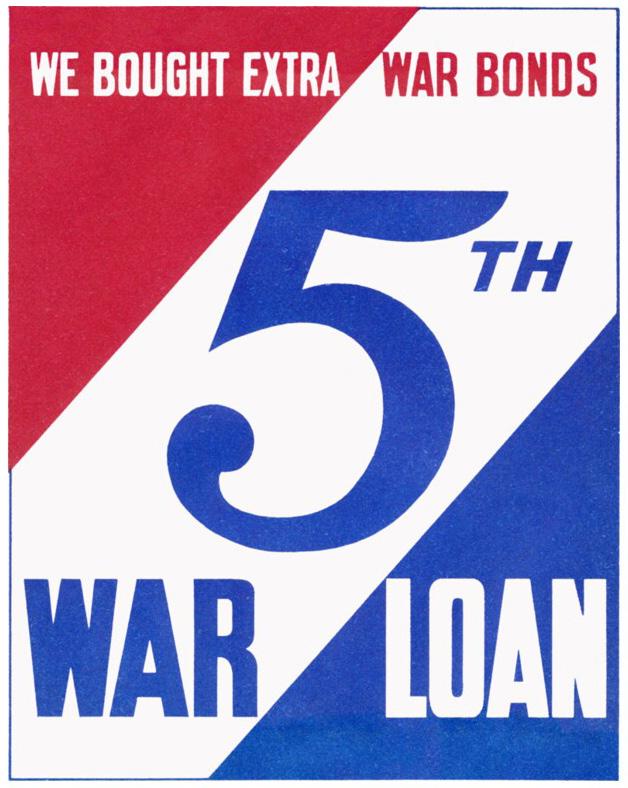
7th WAR LOAN: NOW ALL TOGETHER
C. C. Beall, USA, 1945
Publisher: U.S. Treasury Department, War Finance Division
During World War II, the United States Government used War Bonds to help finance the war effort. Citizens could buy bonds at a set price and then redeem them ten years later at a higher price than what they paid. For example, a $25 war bond could be bought for $18.75 and redeemed for $25 ten years later. Many war bonds were sold through War Loan Drives, national wide multi-week bond selling events that were promoted through posters, parades, and other propaganda tools. This poster is for the 7th War Loan Drive, which ran from May 14, 1945 through June 30, 1945. The total goal for the drive was $14,000,000,000, half of which would come from corporations and the other from individual citizens buying bonds. In order to drum up support, the US Treasury Department chose C. C. Beall to recreate the famous photograph of US Marines raising the American flag on Mount Suribachi, Iwo Jima. Taken on February 23, 1945 by Associated Press correspondent Joe Rosenthal, the photo was printed on the front page of dozens of newspapers
throughout the country. The photograph would eventually land Rosenthal a Pulitzer Prize and was the model for the Marine Corps War Memorial in Arlington, Virginia.
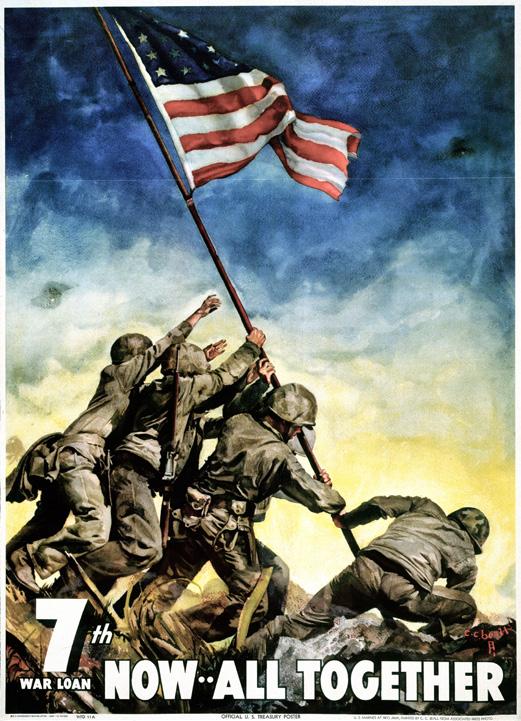
9 NOVEMBER 1923
GEBOREN ALS DEUTSCHER, GELEBT ALS KÄMPFER, GEFALLEN ALS HELD, AUFERSTANDEN ALS
VOLK!
Artist unknown, Nazi Germany, exact date unknown
Publisher: Wochenspruchen der Nationalsozialistische Deutsche Arbeiterparte (NSDAP)
This poster was part of a larger propaganda program known as Wochensprechen der NSDAP, which translates to Weekly Quotation of the Nazi Party. Running from 1937 to 1944, this program used quotations from Adolf Hitler, German historical figures or Nazi Party members to produce posters to spread the ideas and goals of the Nazi Party. In this case, a quote referencing the 1923 Beer Hall Putsch in Munich is used. From November 8–9, 1923, Adolf Hitler led the fledgling Nazi Party in an attempt to start a revolution to overthrow the Weimar Republic. They planned to take over the local government before marching on Berlin, the German capital. The coup failed and during a shootout with Munich Police, fourteen Nazis and four police officers were killed. Hitler was convicted of high treason but received a light punishment of five years in prison. While in prison, Hitler wrote his manifesto Mein Kampf. Many of the men who had part of the coup attempt would be promoted to high positions within Nazi Germany: Hermann Göring (head
of Luftwaffe, Director of the Four Year Plan, and Hitler’s successor), Heinrich Himmler (head of the SS), Rudolpf Hess (Deputy Führer from 1933–1941), Julius Streicher (founder of the antisemetic newspaper Der Stürmer, a key propaganda tool of the Nazi regime), and Wilhelm Frick (Reich Minister of the Interior from 1933–1943 and Reich Protector of Bohemia and Moravia from 1943–1945).
Translation: 9 November 1923: born as a German, lived as a fighter, fell as a hero, rose as a people!
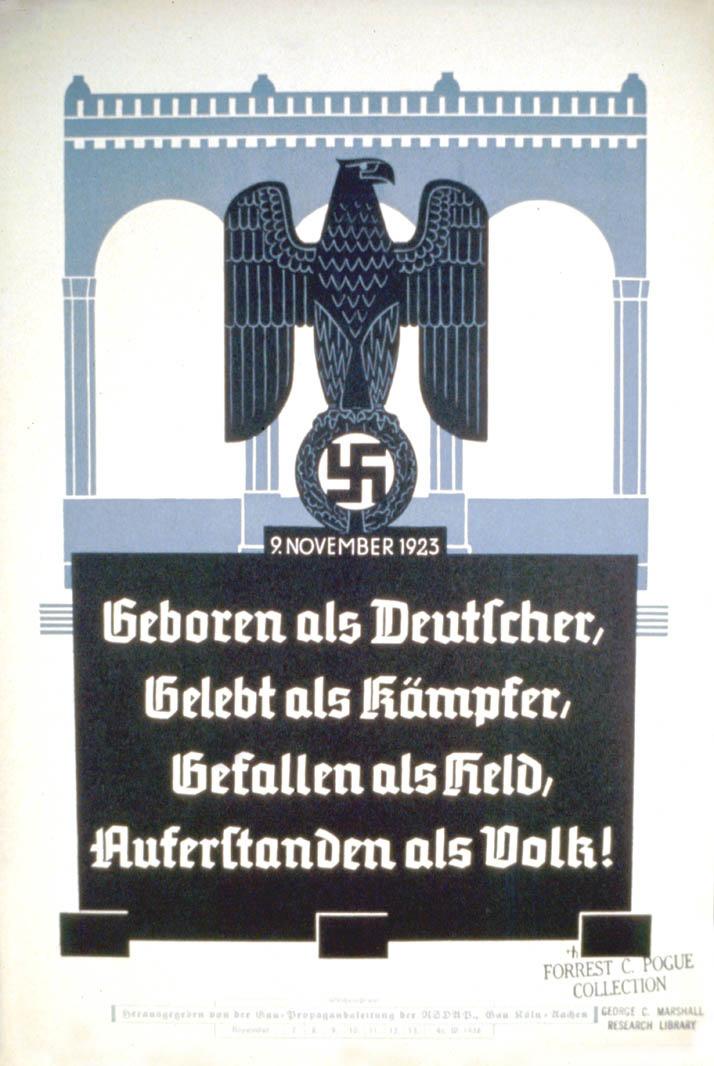
A CARELESS WORD… A NEEDLESS SINKING
Anton Otto Fischer, USA, 1942 Publisher: Office of War Information, no. 24
Throughout the Second World War, all governments were concerned about national security and information being leaked to enemy spies. The United States produced numerous posters warning Americans about being careful with what they wrote and spoke. This poster from 1942 shows the potential consequences of important information being leaked to the enemy. American sailors are shown fleeing a sinking vessel, most likely a cargo ship, with their wounded comrades because the enemy was able to determine their location presumably through an American carelessly discussing sensitive information. Americans were warned to always assume that the enemy was listening, regardless of their surroundings. A manual published by the Office of War Information stated, “Each word an American utters either helps or hurts the war effort. He must stop rumors…He must not speak recklessly. He must remember that the enemy is listening.”

A LIFETIME OF EDUCATION FREE
FOR HIGH SCHOOL GRADUATES WHO QUALIFY
Alexander Ross, USA, 1945 Publisher: Federal Security Agency, U.S. Public Health Service
As their mothers and grandmothers had during the First World War, women in the Second World War contributed to the war effort in a variety of ways, with serving as nurses being one of the most prominent roles. After 1942, there was a nursing shortage, and in 1943, Congresswoman Frances P. Bolton of Ohio created the U.S. Cadet Nurse Corps through legislation to help alleviate this shortage. The program was open to women who were between 17 and 35 years old who had graduated from high school in good academic standing. Uniquely, the Cadet Nurses Corps was not a segregated service and forty Native American women from twenty-five tribes, 3,000 African American women, and numerous Japanese American women enrolled. The foreground of the poster shows a member of the Cadet Nurse Corps in her uniform with two high school aged girls looking at her with admiration.
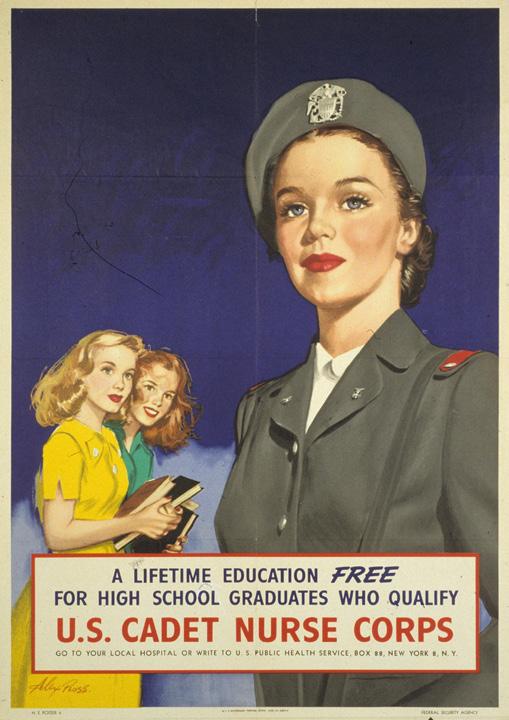
ANSWER THEIR PRAYERS AMERICAN RELIEF FOR HOLLAND
Douglass Crockwell, USA, 1945 Publisher unknown
On May 10, 1940, Nazi Germany invaded the Netherlands in a surprise attack. Queen Wilhelmina and the Dutch royal family fled to the United Kingdom and ruled as the Dutch government in exile for the rest of the war. Three days after the invasion, several Dutch citizens and Dutch Americans formed the Queen Wilhelmina Fund in the United States to raise money to support the Red Cross working in the Netherlands. The organization spread throughout the United States and included President Roosevelt’s mother, Sara Delano Roosevelt, former New York Governor Alfred E. Smith, and Grace Vanderbilt, wife of Brigadier General Cornelius Vanderbilt III, as honorary chairmen. On April 22, 1945, the organization changed its name to American Relief for Holland. The poster shows a Dutch child praying over a small piece of bread in a partially destroyed house while windmills, an iconic symbol commonly associated with the Netherlands, stand damaged in the background.

ARE YOU IN THIS?
Sir R.S.S. Baden Powell, UK, 1915
Publisher: The Parliamentary Recruiting Committee, no. 112 Printer: Johnson, Riddle and Co. LTD
During the First World War, nearly every part of British society mobilized for the war effort. This poster shows the various roles open to British citizens, both men and women. The foreground depicts a male factory worker with a raised hammer. The center shows a female munitions factory worker assembling cartridges and a nurse. In the background, a Boy Scout hands a package to soldier, which could contain anything from ammunition, food, or a care package from home. Behind them, a Royal Navy sailor positions an artillery piece. Off to the right side of the poster, a well-dressed man stands to the side watching scene. The phrase “Are You In This?” was aimed at the people who were not directly involved in the war effort, like the well-dressed man, and galvanized them to do whatever they could. The inclusion of a Boy Scout is notable since the creator of the poster, Lt. Gen. Sir Robert S.S. Baden-Powell, founded the Boy Scouts in the United Kingdom in 1908.

AU PROFIT DES OEUVRES DE GUERRE
Francisque Poulbout, France, 1916
Publisher: Chacoit
This poster was created by Francisque Poulbot, a famous French illustrator. The subjects of many of Poulbot’s illustrations and paintings were children from the poorer sections of Paris, particularly the Monmarte District where the famous Basilica of Sacré-Cœur de Montmartre is located. During World War I, Poulbout briefly served in the French Army. In August 1914, he was mustered into the 11th Land Regiment, 2nd Army Corps but was medically discharged in February 1915. After his discharge, Poulbot began drawing patriotic images for newspapers in Paris as well as illustrating posters promoting government bonds and war charities. Many of these drawings and posters utilized poor Parisian children to elicit emotional responses from viewers. The word “poulbot” entered the French language as a result of Poulbot’s drawings and refers to poor children or street urchins in Paris. Poulbot was inducted into the Légion d’Honneur, France’s highest military and civilian order, for his artistic work during the war. This poster utilizes children and shows them saluting
wounded French soldiers. The girl on the left holds the French tricolor flag which was adopted during the French Revolution (1789-1799). Two of the boys have toy rifles and a third has a toy saber at his side while he salutes the wounded veterans. The combination of wounded veterans, poulbot, and French Revolution imagery was designed to elicit a patriotic response from French citizens in the hope that they would buy war bonds to help finance the war.
Translation: July 14, 1915; Paris Day; For the benefit of the war charities run by the city [Hôtel de Ville]

AWARD FOR CARELESS TALK
Stevan Dohanos, USA, 1944 Publisher: Office of War Information
Steve Dohanos was an American illustrator who painted 125 cover images for the Saturday Evening Post during the 1940s and 1950s. In this poster, Dohanos depicts a hand with a swastika ring holding an Iron Cross, a German medal analogous to the Congressional Medal of Honor, the United States’ highest military award. The Iron Cross was created in 1813 by Prussian King Friedrich Wilhelm III and awarded to those soldiers who showed distinguished service during the Prussian War of Liberation. It was also issued during the Franco-Prussian War, the First World War, and the Second World War. The Second World War variation replaced the Imperial German symbols present on earlier versions with the swastika, the main symbol of the Nazi Party. This poster, along with many others, encouraged Americans to not discuss important military information they might know, such as troop movements, carelessly. The implication for this poster is that if Americans recklessly talk about sensitive military information, they would be awarded an Iron Cross for their contribution to the German war effort.
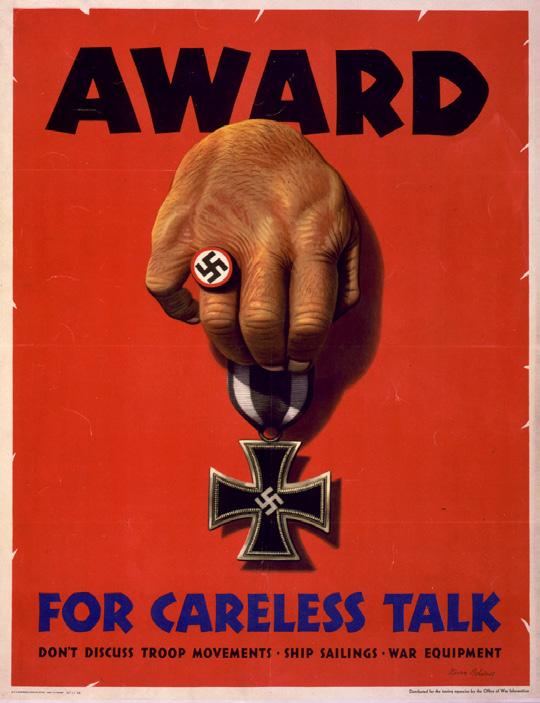
BE A VICTORY FARM VOLUNTEER
IN THE U. S. CROP CORPS
Artist unknown, USA, 1943
Publisher: U. S. Department of Agriculture
During the Second World War, many of the young men in the United States were involved in the war effort in some capacity. As a result, many of the male farm workers were unavailable to harvest crops. Keeping up food production was essential as the United States now had to feed an ever-growing military operating on opposite sides of the world. In order to keep food production running smoothly, the U.S. Crop Corps was established in 1943. Citizens volunteered their time to help local farmers or canneries. Men were organized under the banner of the Crops Corps, teenagers between the ages of 14 and 18 were known as Victory Farm Volunteers, while women were a part of the Women’s Land Army. During 1943, nearly 2.5 million teenagers and 3 million women volunteered their time to help US farm production. Despite the population of farmers declining throughout the war, US food production increased and allowed for the US military to be an effective fighting force.

BE GENEROUS IN VICTORY
GIVE A VIRGINIAN’S SHARE
Artist unknown, USA, exact date unknown Unknown publisher (possibly related to Richmond Community Fund/United Way)
Very little information is known about this poster. The slogan “Be Generous in Victory!” was also used by the Richmond Victory and Community Fund which raised funds for various causes during the war. It is possible that the Richmond Victory and Community Fund was known as the Richmond War and Community Fund during World War II. The Richmond War and Community Fund was a merger of the Richmond Community Fund and the Richmond War Effort. The Richmond Community Fund was the precursor to the Richmond Chapter of United Way, a non-profit charity. The poster seems to be drawing upon prominent figures of Virginia history to encourage monetary support for the war effort. The inclusion of Stonewall Jackson and Robert E. Lee might mean that this poster was possibly meant to be displayed in the Shenandoah Valley, given Jackson’s campaign in the valley in 1862.
Special thanks to Dana Angell from the Library of Virginia for her help researching this poster.
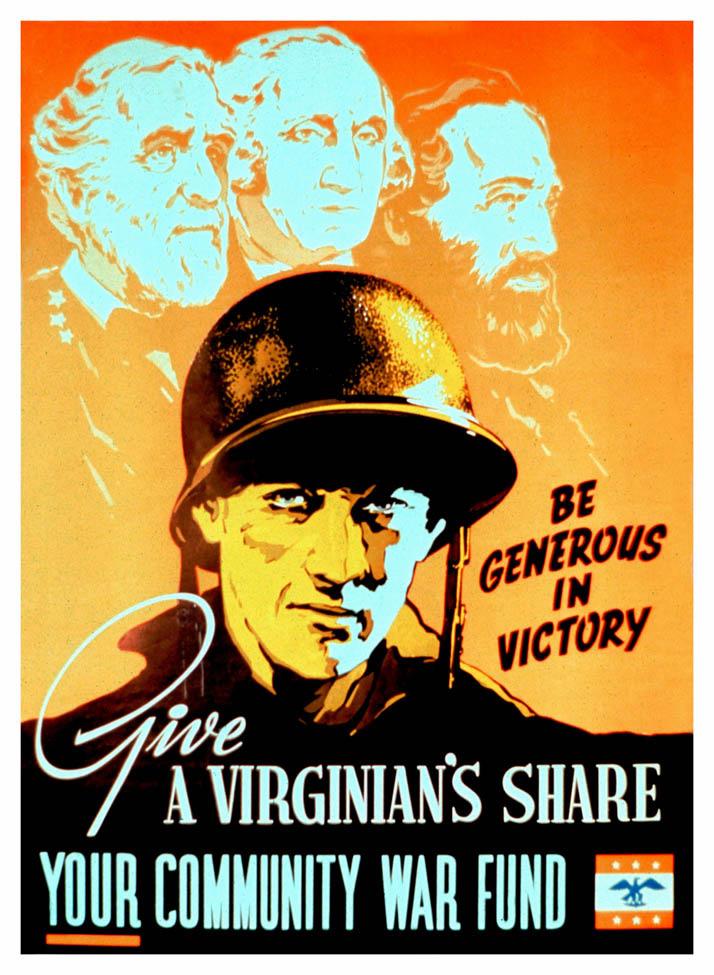
BEAT BACK THE HUN
WITH LIBERTY BONDS
Frederick Strothmann, USA, 1918 Unknown
publisher
Frederick Strothmann was a talented illustrator with an extensive career prior to World War I. He illustrated three of Mark Twain’s works and illustrated for Harper’s Magazine, The Saturday Evening Post, Good Housekeeping, Colliers’, and Life magazine. He designed this poster as part of a contest for the Fourth Liberty Loan Drive during World War I. Much like its Second World War counterpart, Liberty Loan Drives were the sale of bonds to the general public in order to finance the war effort in World War I. Americans who purchased bonds could cash them in at a higher price several years later. Strothmann submitted this design as part of a nation-wide contest and was one of nine submissions selected to be mass produced as posters. Strothmann played upon the fears of the American people by depicting a German soldier as a monster, with bloody hands crushing the ruins of city and blood dripping from his bayonet. The term “Hun” was a slang term used to refer to German soldiers and was derived from a speech given by Kaiser Wilhelm
II in 1900. In a farewell address to his troops as they left to go help quell the Boxer Rebellion in China, Wilhelm II encouraged his soldiers to be as ruthless as the Huns, a nomadic group that invaded eastern and southeastern Europe in the 4th century A.D. The Huns gained a reputation as ruthless and fierce warriors and frequently clashed with the Roman Empire in the 5th century A.D. Wilhelm II’s evocation of the brutal Huns was a public relations nightmare for Germany and when the First World War broke out, “Hun” became the go to term for Germany in Allied anti-German propaganda.

CAN ALL YOU CAN
IT’S A REAL WAR JOB!
Artist unknown, USA, 1943
Publisher: Office of War Information
During World War II, American citizens were encouraged to grow Victory Gardens to supplement the rations they received. Most of the commercially produced food was being harvested and canned to be sent to the troops and Victory Gardens would allow American families to supplement their diets with homegrown vegetables. In order to have additional food in the winter months after the growing season ended, families were encouraged to can vegetables from their Victory Garden. Vegetables would be placed in glass jars with metal lids and boiled in water to seal and keep them fresh.
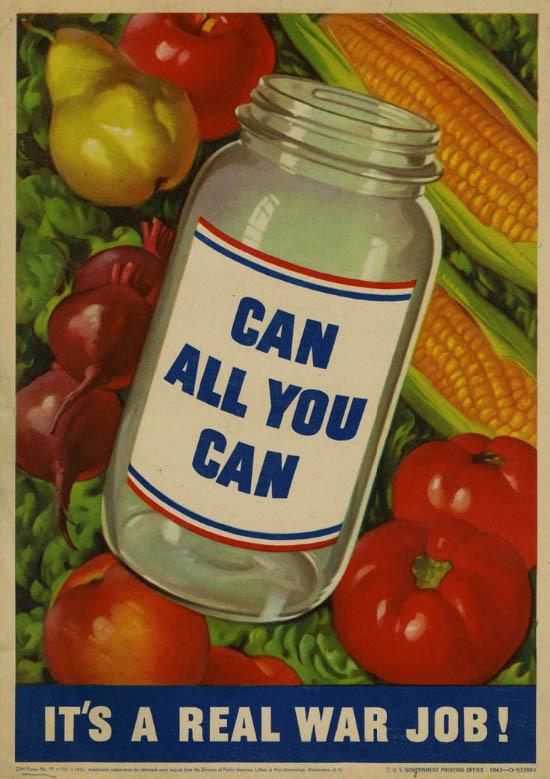
CARELESS MATCHES AID THE AXIS
Unknown artist, USA, 1942
Publisher: U. S. Department of Agriculture and U. S. Forest Service
During the Second World War, anything that hurt the United States economically, militarily, or politically was viewed as win for the Axis powers. This poster is encouraging Americans to be careful with fire to prevent forest fires from breaking out and spreading. Wood was an essential war material and was used in a variety of things including airframes for aircraft and stocks for rifles. The depiction of a Japanese soldier highlights the anti-Japanese sentiment of many Americans during the war. Many propaganda posters depicted Japanese soldiers with small, beady eyes, oversized buck teeth, and large ears. Others depicted the Japanese as inhuman monsters. Often, Japanese Emperor Hirohito or Prime Minister Hideki Tojo were the basis of Japanese depictions in these posters. This poster shows the common Japanese stereotypes: big ears, beady eyes, and buck teeth. Given the shape of the glasses, it is possible that this caricature was based on Hirohito.
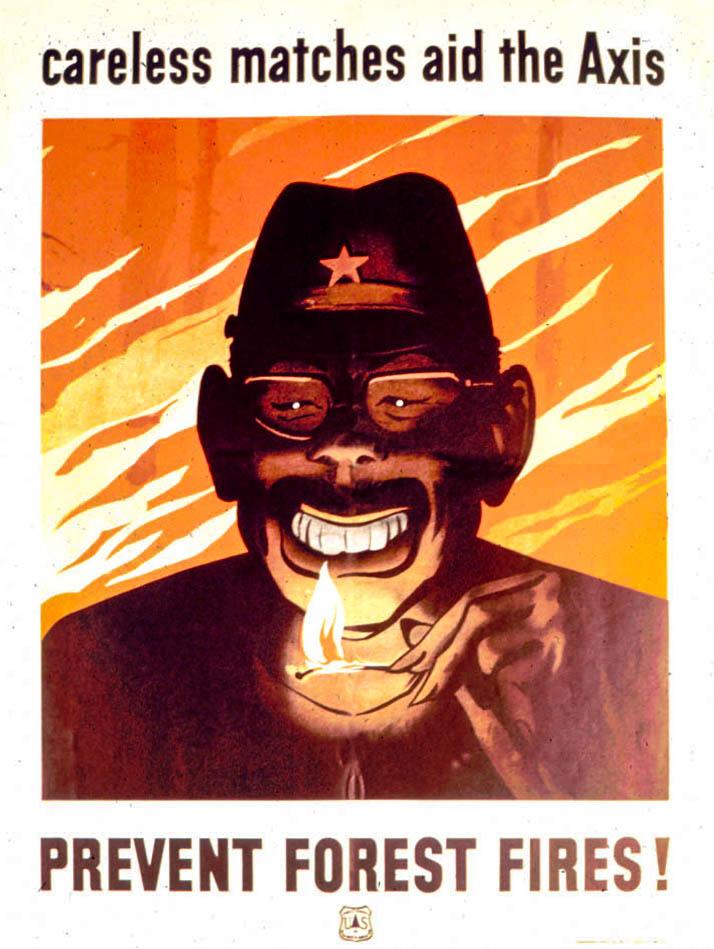
CETTE FOIS JUSQU’A BERLIN
Unknown artist, France, exact date unknown Unknown publisher
This poster depicts the flags of France, the United States, Great Britain, and the Soviet Union as if they were moving to the east. The caption references the First World War where the Allied powers did not make it to the German capital Berlin, as Germany surrendered in November 1918. With the Second World War, the Allies planned to go all the way to Berlin to defeat Germany, but only the Soviets made it to Berlin before Germany surrendered. This poster was also produced in Dutch with a Belgian flag replacing the French in the foreground.
Translation: This time to Berlin

CHINA, FIRST TO FIGHT!
Martha Sawyers, USA, exact date unknown Unknown publisher
Although many believe the Second World War began with the invasion of Poland in 1939, some scholars argue that the war began with the Second Sino-Japanese War in 1937 when Japan invaded China. United China Relief was a fundraising organization established in March 1941 in the United States to raise money to help China with medical, educational, and economic needs. The organization was part of the National War Fund, which was a coalition of relief groups who banded together to raise money for various relief projects. United China Relief coordinated several smaller organizations focused on fundraising for China with a goal to raise $5,000,000 by July 31, 1941. United China Relief continued to raise funds for China throughout the war. The badge on the soldier’s hat is the symbol of the Kuomintang, the Chinese Nationalist Party, one of the main political factions within China during the war.
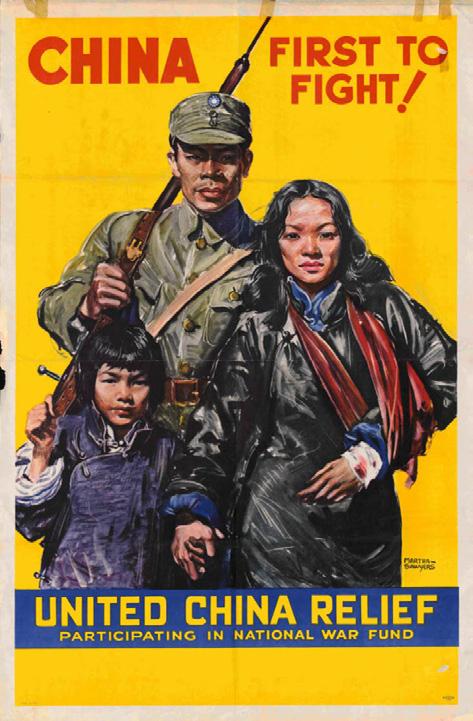
COMPTOIR NATIONAL D’ESCOMPTE DE PARIS
Auguste Leroux, France, 1918
Publisher: Joseph Charles
In the aftermath of the French Revolution of 1848, which saw the formation of the Second French Republic, the Comptoir National d’Escompte de Paris was created to help stabilize the new republic’s finances. It became Banque Nationale de Paris in 1966 and BNP Paribas in 2000. During the First World War, the Comptoir National d’Escompte de Paris participated in various loan drives to help finance the war. These functioned in a manner like war bond drives in the United States during both world wars. This poster was designed by Auguste Leroux for the Fourth War Loan, known as the Liberation Loan. It lasted from October 20 to November 24, 1918 and the poster highlights one of the major French goals of the war, the recovery of Alsace and Lorraine. These territories were located on the French-German border and had been traditionally French territories since 1648. However, as a result of the French defeat during the Franco-Prussian War (1870-1871), they had been taken by Germany. Still feeling the humiliation of their loss a generation earlier,
France wanted to reclaim Alsace and Lorraine. Leroux’s poster highlights this goal by depicting two women, one dressed in the traditional clothing of Alsace (left) and the other in the traditional dress of Lorraine (right). Both women have a French tricolor cockade in their hats and the caption reads “To hasten Victory and to see us again soon, subscribe!” Leroux plays upon the patriotic sentiment of returning Alsace and Lorraine to France to encourage citizens to contribute to the war loan effort.
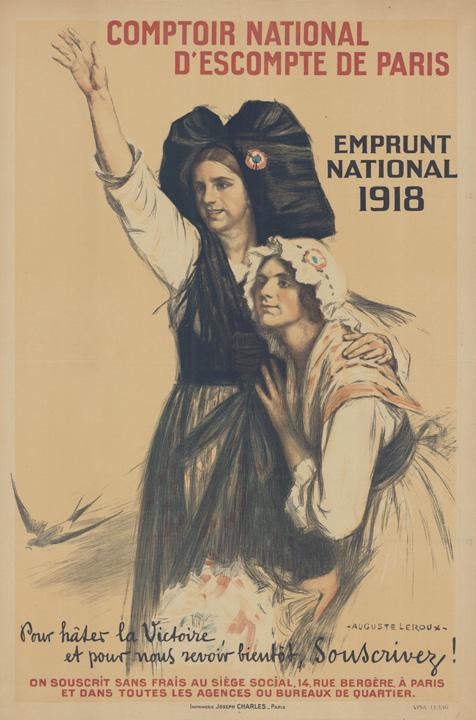
COURAGE AND GALLANTRY IN ACTION
Jes Wilhelm Schlaikjer, USA, 1943 Publisher: U. S. War Department
This is part of a series of portraits painted by Jes Wilhelm Schlaikjer. Schlaikjer was born on the Kaiser Wilhelm der Grosse, a German ocean liner, to a Danish father and an American mother in 1897. Raised in South Dakota, Schlaikjer joined the US Army Signal Corps in World War I and was stationed in Paris as a radio operator. He attended the L’Ecole Nationale des Beaux-Art in Lyons, France and the Art Institute of Chicago after the war. He continued his artistic career in the interwar period and received numerous awards and prizes for his paintings. During the Second World War, Schlaikjer was selected to be a War Department artist at the Pentagon where he painted portraits of leading military figures including General Dwight D. Eisenhower and General George S. Patton. Additionally, he designed several posters promoting the military and the Red Cross. This poster is promoting the U.S. Army Infantry. A U.S. infantryman is at the center of the poster in full gear holding an M1 Garand rifle with a bayonet attached. He stands amidst an explosion with destroyed tanks and artillery pieces at
the bottom poster. On the top right corner, the shadowy silhouettes of Minutemen or soldiers of the Continental Army are depicted in profile and can be identified by their distinctive tricorne hats.
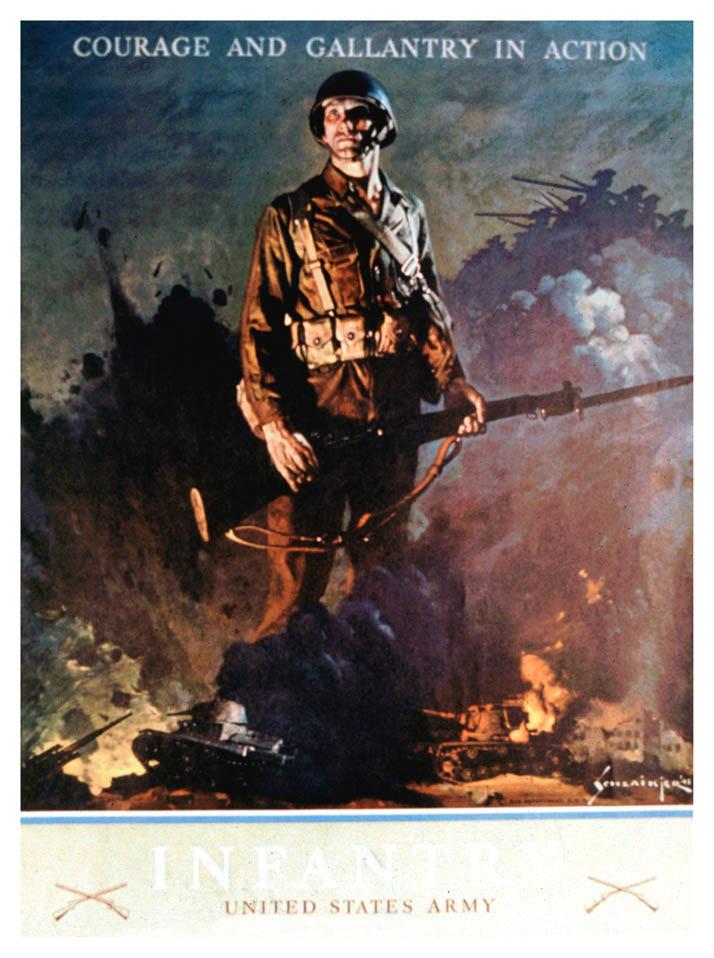
CREDIT COMMERCIAL DE FRANCE
Lucien-Hector Jonas, France, 1918 Publisher:
Chacoin
This poster was produced by Credit Commerical de France, a major French bank, to promote the 4th National Defense Loan. In the foreground, the poster depicts French and British solders combat, with a French soldier preparing to toss a hand grenade and a British soldier aiming down his rifle. In the background, the figure of Victory leads a large column of American troops into battle. With the United States’ entry into the war, its industry and manpower provided a significant boost to the Entente Powers.
Translation: Subscribe for Victory and for the Triumph of Liberty
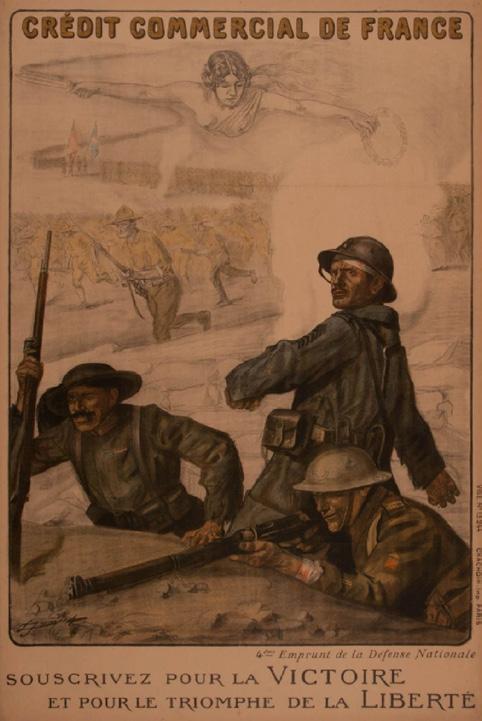
DO WITH LESS— SO THEY’LL HAVE ENOUGH
Unknown artist, USA, 1943
Publisher: Office of War Information, Division of Public Inquiries
This poster highlights one of the major ways that average citizens could contribute to the war effort during World War II. Rationing was implemented across the nation so that more materials could be used to equip and supply the troops. War also disrupted international trade which caused further limitations. Everything from butter to gas was rationed and Americans were given ration books which dictated how much of each good they could purchase every week. Posters like this one encouraged Americans to follow the rationing program in order to help American soldiers in the field.
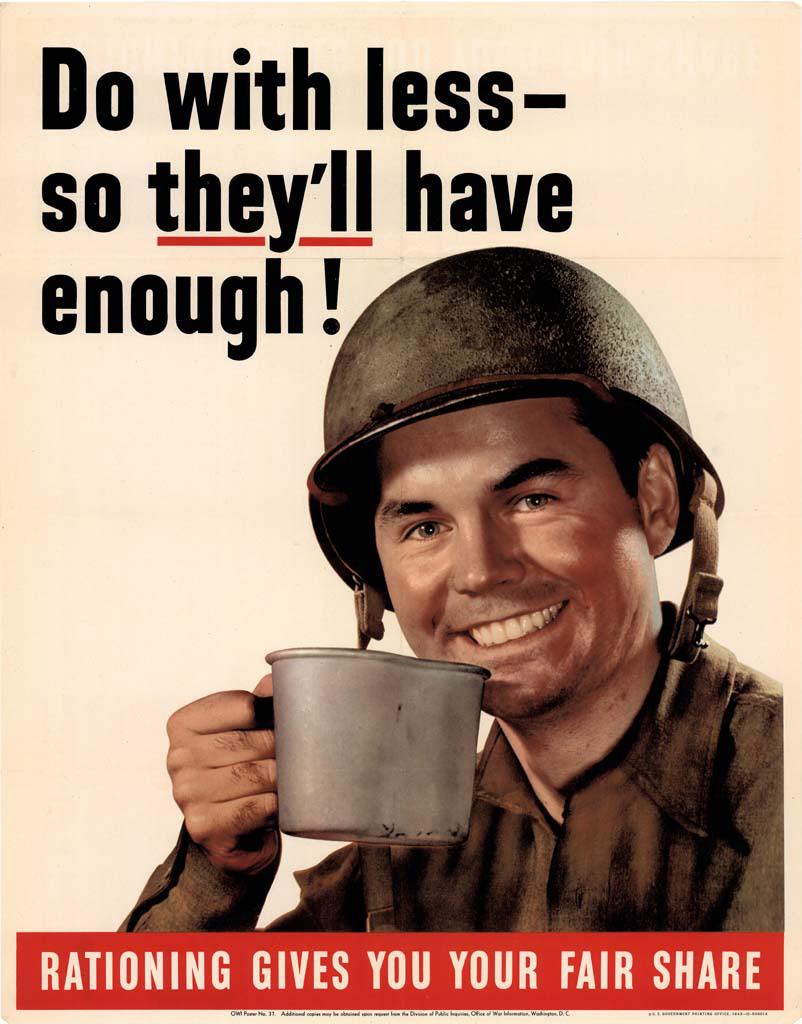
DOING ALL YOU CAN, BROTHER?
BUY WAR BONDS
Robert Smullyan Sloan, USA, 1943 Publisher: U. S. Government Printing Office
This poster plays upon the emotions of the viewer to encourage the sale of war bonds. A wounded 2nd lieutenant, denoted by the single gold bar on his shoulder, is depicted on a bombed-out battlefield. The language of the caption specifically targets men, especially those who were not serving on the frontlines. This combination was designed to evoke a sense of guilt and the poster implies that the way to remove that guilt was to purchase war bonds.
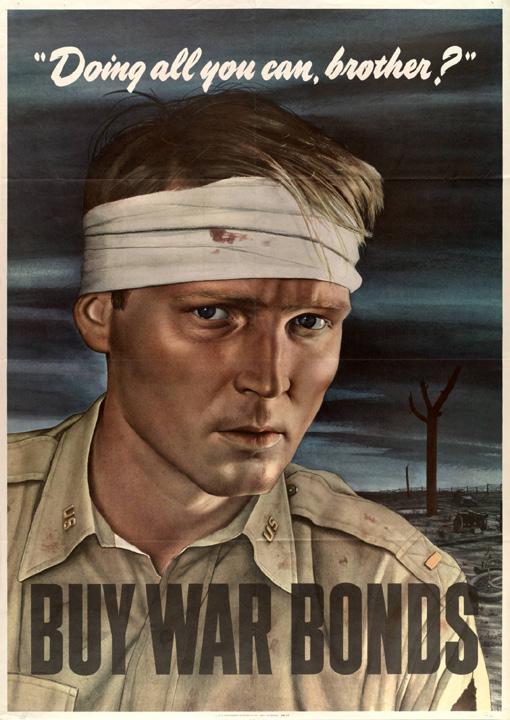
DON’T LET THAT SHADOW TOUCH THEM
BUY WAR BONDS
Lawrence Beall Smith, USA, 1942 Publisher: U. S. Government Printing Office
This poster, like many others, is designed to encourage the purchase of war bonds. Instead of using images of soldiers, it uses depictions of children to evoke a strong sense of protection. The two younger children are oblivious to the large shadow of the Swastika, while the older boy is looking towards it with a protective hand stretched in front of the younger boy. The caption urges viewers to purchase war bonds so that American children will spared from the looming threat of Nazism and fascism.
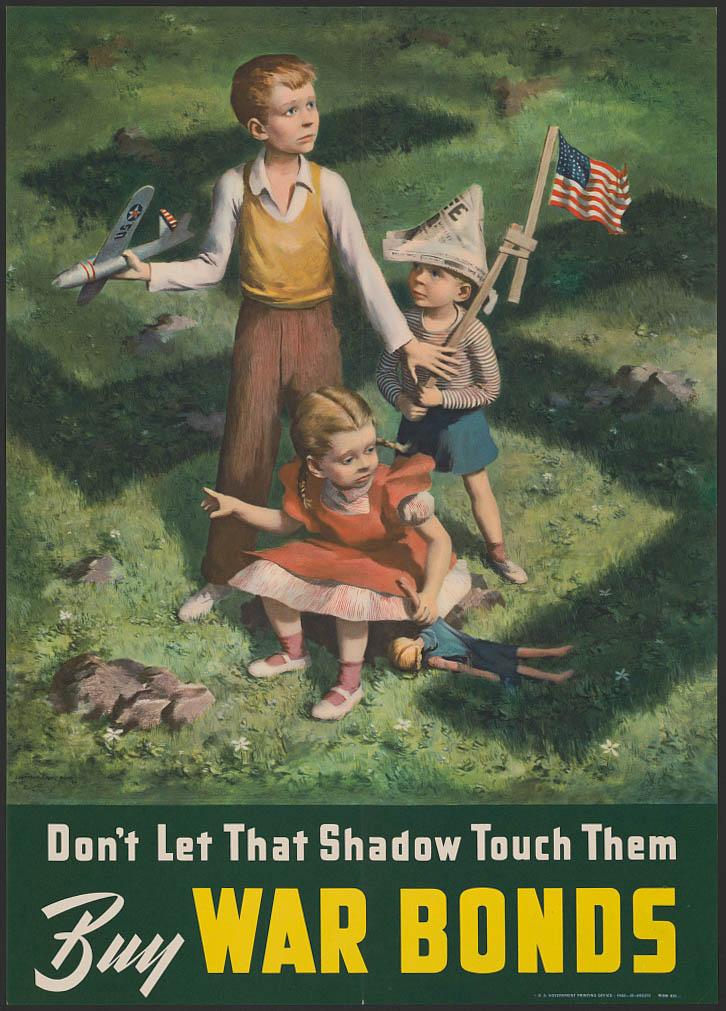
EMPRUNT DE LA LIBERATION
Firmen Boursset, France, 1918
Publisher: Vaugirard
This poster is promoting a war loan drive during World War I. A Scottish soldier stands on the left ready to throw a hand grenade, a French soldier stands in the middle waving his helmet, and either an American or British soldier is on the right aiming down his rifle. Given that this poster was published in 1918, it is possible that this is supposed to be an American soldier, but given the similarities of British and American uniforms, it is difficult to tell. The bottom text informs viewers where they can purchase war loans, in this case, at London County & Westminster Bank in Paris.
Translation: Libration Loan / We Have Them

ENTRE LE MARTEACU ET L’ENCLUME!
Jean Carlu, France, 1944
Issuing Body: Gouvernement provisoire de la Republique francaise. Secretariat general a l’information Publisher: McCandlish Litho. Co.
This Second World War poster depicts the breaking of Nazi Germany between the hammer and anvil of Allied forces. The hammer is composed of the United Kingdom, the United States, France, and the Soviet Union. The anvil is Free France, denoted by the Cross of Lorraine on the French Flag. Free France was the French government in exile led by Charles de Gaulle during the war. It was distinct from the Nazi puppet government of Vichy France, which was led by Marshal Philippe Pétain. Pétain was a French national hero who distinguished himself during World War I.
Translation: Between the Hammer and the Anvil!

EVERYONE SHOULD DO HIS BIT
Baron Low, UK, 1915
Publisher: The Parliamentary Recruiting Committee, no. 121
In this British poster from the First World War, a young man, presumably a member of the Boy Scouts, poses with a drum. Behind him is a wall full of various posters encouraging enlistment in the British military. The enlistment posters were all published by the Parliamentary Recruiting Committee, which produced this poster as well.
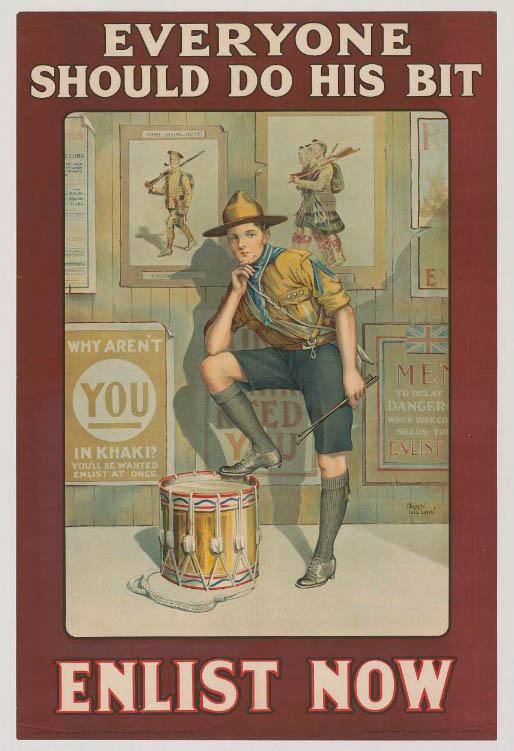
FEIND HÖRT MIT!
Unknown artist, Nazi Germany, exact date unknown Unknown publisher
Like the United States, Nazi Germany was concerned about enemy spies and confidential information being leaked out. This poster depicts a German soldier discussing troop movements with a woman. The poster warns the German people to be careful about what they say and to whom they say it.
Translation: The enemy is listening! “Lost half a day! Troop transports were…”
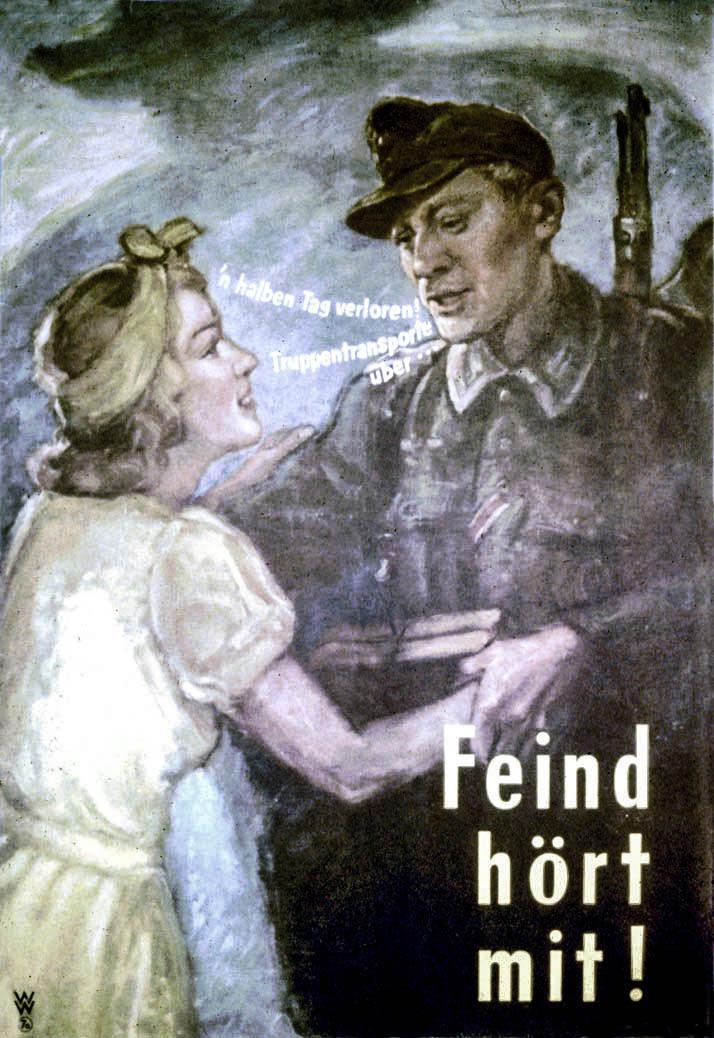
FIRE AWAY!
BUY EXTRA BONDS
Georges Schreiber, USA, 1944 Publisher: U. S. Government Printing Office
This poster is promoting the 5th War loan Drive in the United States. The drive lasted from June 12 to July 8, 1944 and raised well over $16,000,000,000. The poster is based on a painting by Belgian born artist Georges Schreiber. Schreiber and another artist, Thomas Hart Benton were tasked by the Navy to spend time with the crew of the USS Dorado, a newly commissioned submarine, in 1943. While the crew sailed four short cruises to test the ship (known as shakedown cruises), Benton and Schreiber created numerous paintings depicting life aboard the submarine. After the shakedown cruises, Benton and Schreiber returned to their homes to complete the paintings and the USS Dorado, despite encountering numerous problems during the shakedown cruises, sailed for the Panama Canal. The USS Dorado never reached Panama and one of Schreiber’s paintings entitled “Who Are You?” was chosen by the War Department to help advertise the 5th War Loan in 1944. The top left corner of the poster memorializes the USS Dorado. Various theories circulated
surround the USS Dorado and the US Navy decided that the submarine had been accidentally hit by a US patrol bomber on its way to Panama.
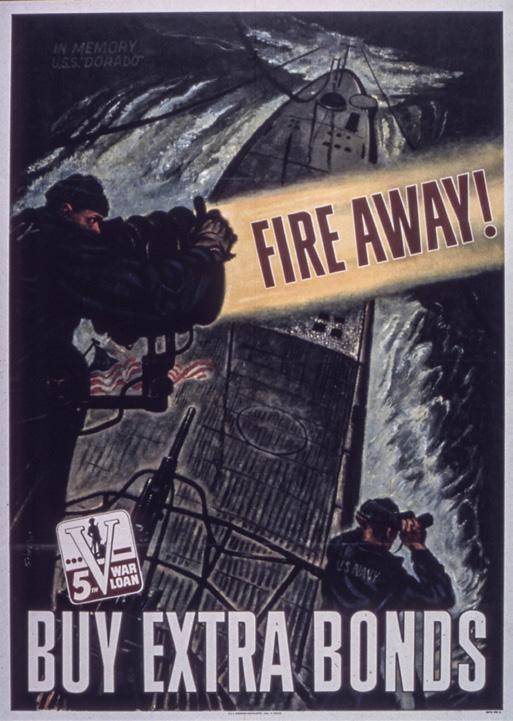
FORWARD!
FORWARD TO VICTORY
Lucy Elizabeth Kemp-Welch, UK, 1914
Publisher: The Parliamentary Recruiting Committee, no. 133 Published in 1914, this First World War British poster depicts a cavalryman at the charge with his saber outstretched. British cavalry played an important role in numerous conflicts during the 19th century, including the Battle of Waterloo in 1815 and the Battle of Balaklava in 1854. By the First World War, cavalry was obsolete on the battlefield. While useful for reconnaissance and scouting, the advent of machine guns and barbed wire severely limited the effectiveness of cavalry charges, though some did take place in the early stages of the war. The artist who created the poster, Lucy Elizabeth Kemp-Welch, was famous for her paintings of horses and in 1915 was commissioned to provide illustrations for an edition of the book Black Beauty by Anna Sewell.
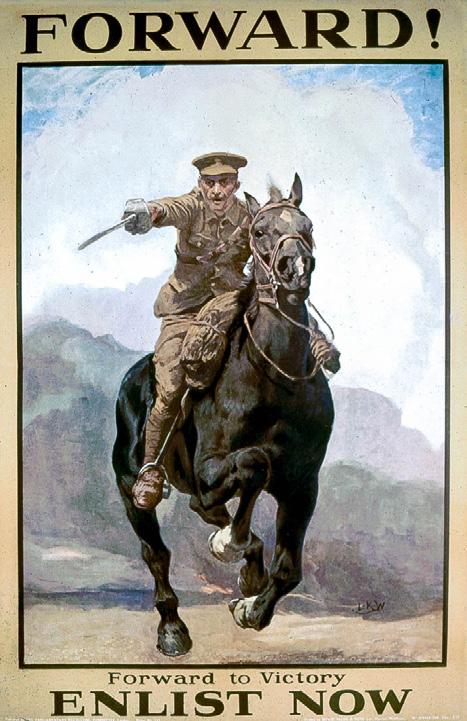
FOUR FREEDOMS
Norman Rockwell, USA, 1943
Publisher: Office of War Information, no. 46
President Franklin D. Roosevelt identified four universal freedoms that all people possessed in his State of the Union address on January 6, 1941. One of the freedoms he identified was the freedom from fear. Painted by Norman Rockwell, this poster depicts parents tucking their children into bed for the night. The children sleep soundly, oblivious to the perils of the world. The father stands over his sleeping children while the newspaper in his hand has a headline about bombing raids. This could be a reference the Blitz, a German bombing campaign against Great Britain, or any number of bombing attacks on Allied nations
OURS…TO FIGHT FOR: FREEDOM FROM FEAR
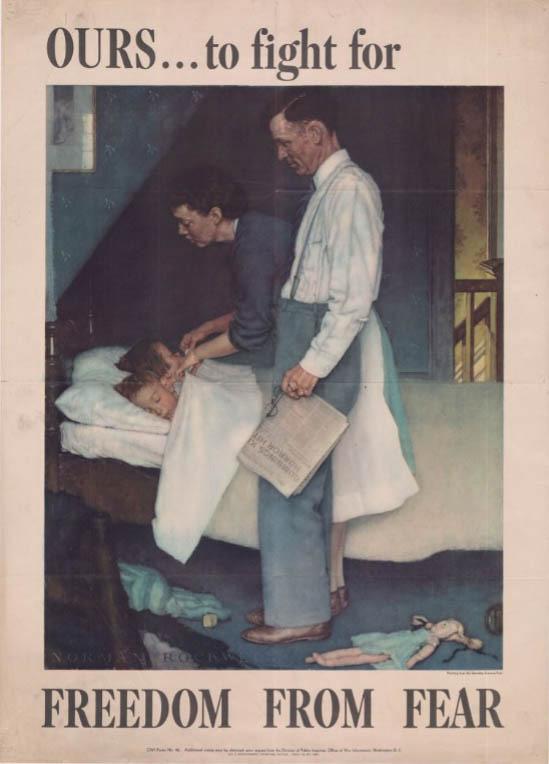
FOUR FREEDOMS
Norman Rockwell, USA, 1943
Publisher: Office of War Information, no. 45
this painting depicts several generations of an American family gathered around a table for a Thanksgiving meal, as indicated by the turkey and the abundance of food on the table. Thanksgiving was established by Abraham Lincoln and FDR cemented the holiday as falling on the second to last Thursday in November.
OURS…TO FIGHT FOR: FREEDOM FROM WANT
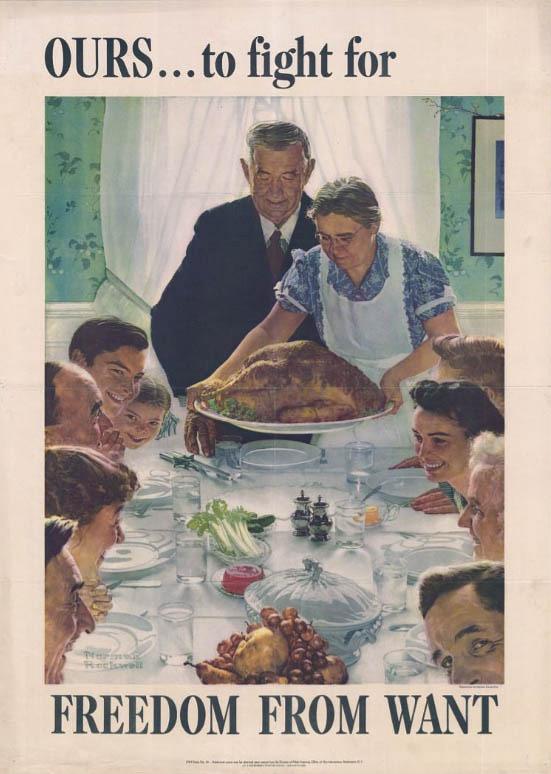
FOUR FREEDOMS
Norman Rockwell, USA, 1943
Publisher: Office of War Information, no. 44
this painting shows a man standing up at a town hall meeting, presumably to offer his opinion on an issue. His clothes imply that he is a blue-collar worker while he is surrounded men in suits. Without explicitly stating it, Rockwell is showing that everyone in America has freedom of speech, regardless of social class or profession.
SAVE FREEDOM OF SPEECH BUY WAR BONDS
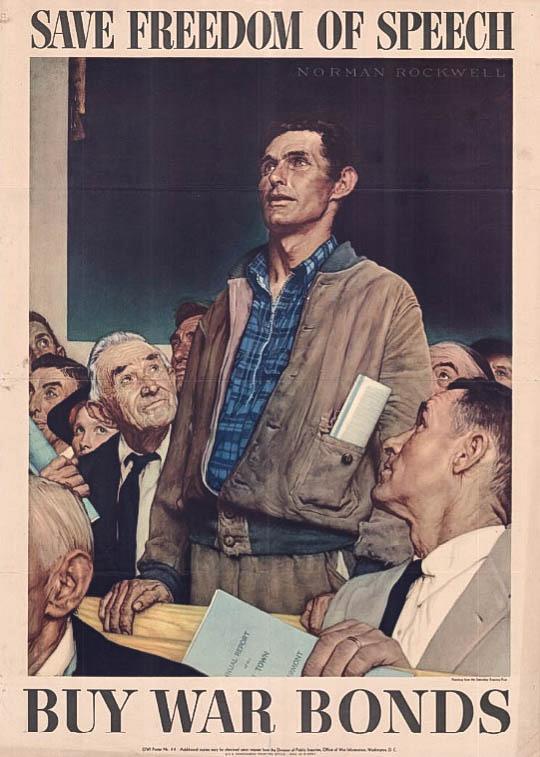
FOUR FREEDOMS
BONDS
Norman Rockwell, USA, 1943
Publisher: Office of War Information, no. 43
Painted by Norman Rockwell, this poster shows several people in prayer. In the foreground, a man wears a head covering, possibly representing Judaism. In the center, an older woman folds her hands prayer, possibly representing Protestantism. On the left, a young woman holds a rosary or prayer beads, possibly representing Catholicism. Within this painting, Rockwell represented the three major religious groups within the United States and highlighted what would be lost if the Axis powers won.
SAVE
FREEDOM OF WORSHIP BUY WAR
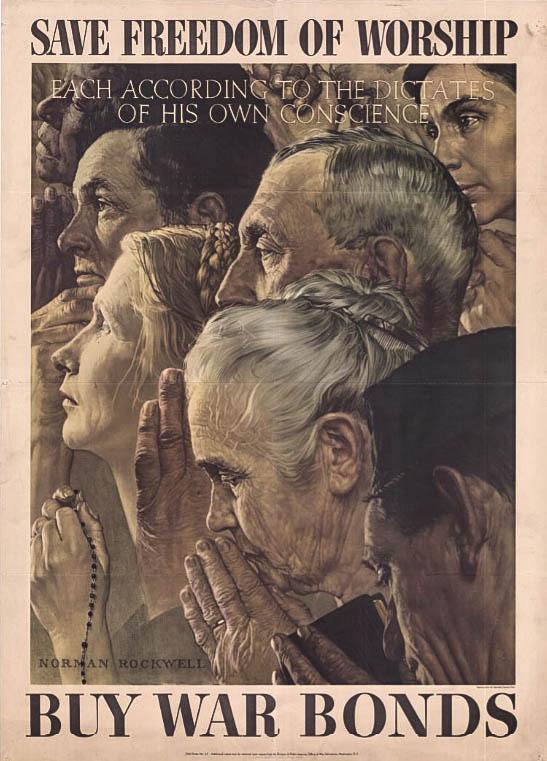
FRIEDRICH DER GROSSE
Unknown artist, Nazi Germany, exact date unknown Publisher: Wochenspruchen der Nationalsozialistische Deutsche Arbeiterparte (NSDAP)
This poster was part of a larger propaganda program known as Wochensprechen der NSDAP, which translates to Weekly Quotation of the Nazi Party. Running from 1937 to 1944, this program used quotations from Adolf Hitler, German historical figures or Nazi Party members to produce posters to spread the ideas and goals of the Nazi Party. In this instance, Frederick the Great is used. Frederick the Great was the king of Prussia, a German state, from 1740 through 1786. During that time, he elevated Prussia from a secondary power to one of the preeminent powers in Continental Europe. Frederick was an expert tactician and ruler, as he established a governmental system that protected religious and social freedoms that was used as a model by other nations throughout the 19th century.
Translation: “Frederick the Great” “The hero’s high soul must be an example to the greatest as well as to the smallest in every situation.”

HARTE ZEITEN HARTE PFLICHTEN HARTE HERZEN
Fritz R. Weber, Nazi Germany, 1943
Publisher: Rehse Archiv für Zeitgeschichte und Publizistik, DLC Published in 1943, this poster shows young German men leaving their tools behind and grabbing rifles to go fight for Germany. 1943 was a turning point in the war for Germany: the Afrika Korps surrendered to the Allies, the Soviet Union launched counter-offensives on the Eastern Front, and the Allies begin bombing German cities like Hamburg. The title of the poster reflects the difficult position Germany found itself in and the art of the poster appears to encourage young German men to leave their factory jobs to fight. The man in the middle hands his tools to a woman while the man in the foreground has picked up a rifle, bayonet and helmet while still in his work clothes.
Translation: “Hard Times. Hard Duties. Hard Hearts.”
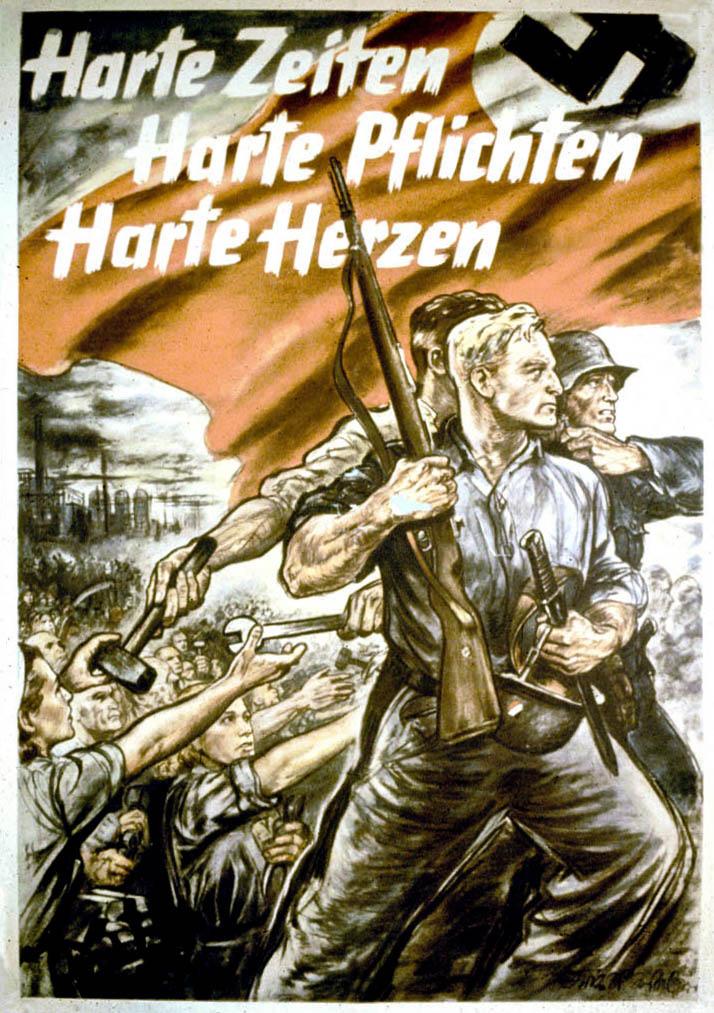
HAVE YOU ANSWERED THE RED CROSS CHRISTMAS ROLL CALL?
Harrison C. Fisher, USA, 1918 Publisher: American National Red Cross
During the First World War, the American Red Cross held yearly events to expand their membership. These “roll calls” took place around Christmas and members of the public could join the Red Cross for $1. These funds and other donations from members were used by the Red Cross to provide assistance to both soldiers and refugees during the war and veterans after the war. These roll calls and other events helped the American Red Cross expand from 107 local chapters in 1914 to over 3,800 by 1918. In total, the Red Cross would raise over $400 million from public contributions during World War I.

HAVE YOU REALLY TRIED TO SAVE GAS
BY GETTING INTO A CAR CLUB?
Harold von Schmidt, USA, exact date unknown Publisher: U. S. Government Printing Office
Once the United States entered the Second World War, all available resources were diverted to the war effort. Rationing was implemented nationwide on nearly everything that Americans consumed or used in their daily lives. One of the most important things that was rationed was gasoline. The Second World War was fought with mechanized infantry and artillery and gasoline was essential for moving troops and equipment. In order to ensure that as much gasoline as possible was available for military use, the United States implemented a nationwide “Victory Speed” of thirty-five miles per hour and promoted carpooling through car-sharing and car clubs. Through lowering the speed-limit and carpooling, Americans reduced the amount of gasoline they consumed which left more to be used by the military.
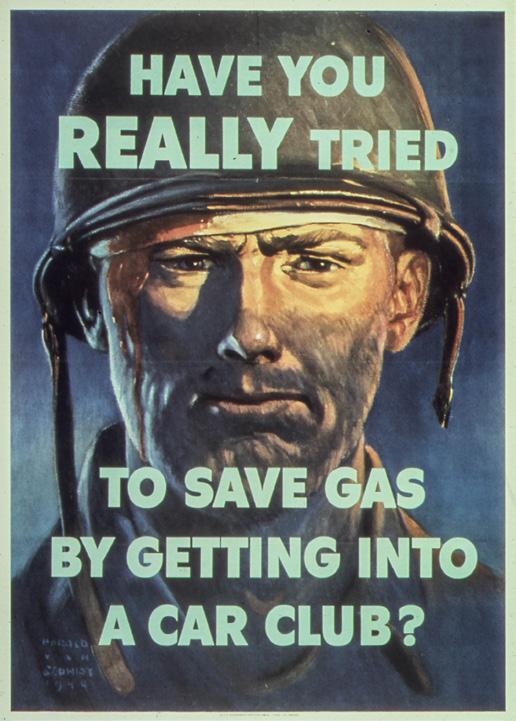
HE’S A “FIGHTING FOOL”
Artist identified as Noxon, USA, 1942
Publisher: War Production Board
This poster was one of many produced by the War Production Board to encourage factory workers. U.S. factories produced a variety of materials during the war including aircraft, Jeeps, firearms, uniforms, ammunition, and other equipment. While much of what was produced was sent to American troops, the United States also sent goods to its allies, primarily Great Britain and the Soviet Union.

I WANT YOU
FOR THE U. S. ARMY
James Montgomery Flagg, USA, 1940 Publisher: U. S. Army Recruiting Publicity Bureau
This is one of the most recognizable propaganda posters in American history. It shows the image of Uncle Sam pointing to the viewer, urging enlistment into the U.S. Army. This example is from the Second World War, but the original poster was designed by James Montgomery Flagg during World War I. It first appeared on the cover of the July 6, 1916, edition of Leslie’s Weekly, a magazine that was first published in 1855. Flagg based the design off a British propaganda poster that was designed in 1914 by Alfred Leete. Leete’s version depicted Lord Kitchner, the Minister of State for War in the United Kingdom, in a similar pose with a similar message encouraging enlistment.
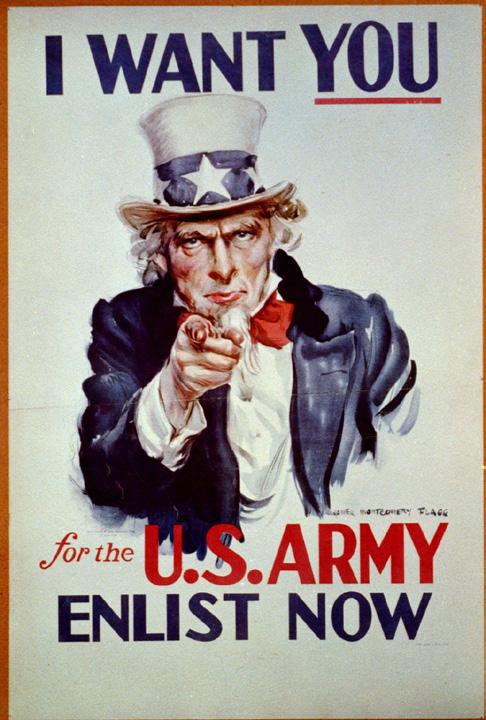
I’LL CARRY MINE TOO!
TRUCKS AND TIRES MUST LAST TILL VICTORY
Valentino Sarra, USA, 1943
Publisher: Office of War Information, no. 28
As a part of gas rationing, Americans were encouraged to not use their personal vehicles as much possible to make them last until the war was over. Automotive manufacturers switched from producing cars for the public to producing war goods for the military including Jeeps, trucks, aircraft, and weapons. The federal government stored the remaining unsold cars and issued them to doctors, firefighters, police, and farmers. In addition to gasoline rationing, rubber was also rationed as it was essential for many military applications including tires, gas masks, and life rafts. This poster is encouraging Americans to walk to the grocery store to save gas and reduce wear on the tires of their personal vehicles to ensure that they would last until the war was over.
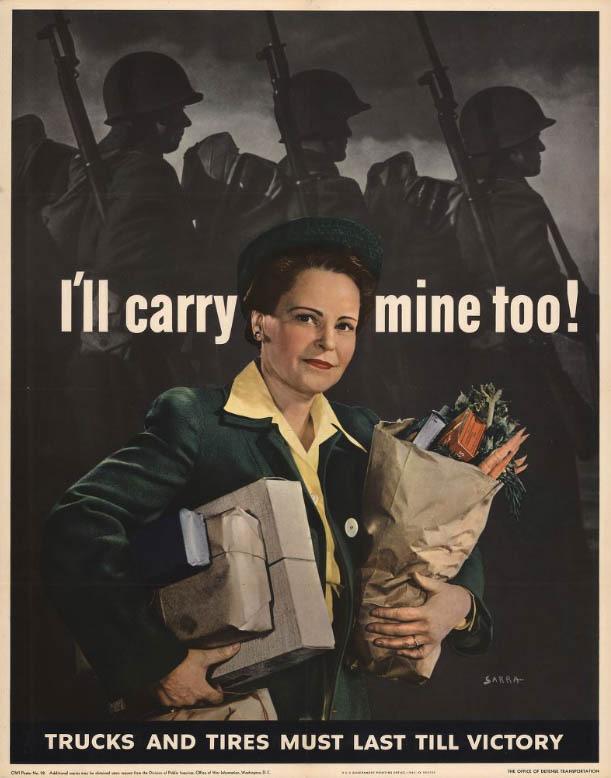
IN THE FACE OF OBSTACLES—COURAGE
Jes Wilhelm Schlaikjer, USA, 1943 Publisher: U. S. War Department
This is another poster painted by Jes Wilhelm Schlaikjer to promote the U.S. military. This poster depicts a three–man machine gun team operating a M1917 Browning machine gun. Designed by American John Moses Browning in the early 1900s, the M1917 was used by American forces in World War I and World War II. The large cylinder at the end of the machine gun is a water jacket. The tube coming down from the bottom of the jacket would be connected to a canister full of water which would help keep the barrel cool while the gun was being fired. In the poster, one man is firing the machine gun, while the man on the far right is feeding in more ammunition belts into the gun, and the man in the foreground is bringing up more boxes of ammo.
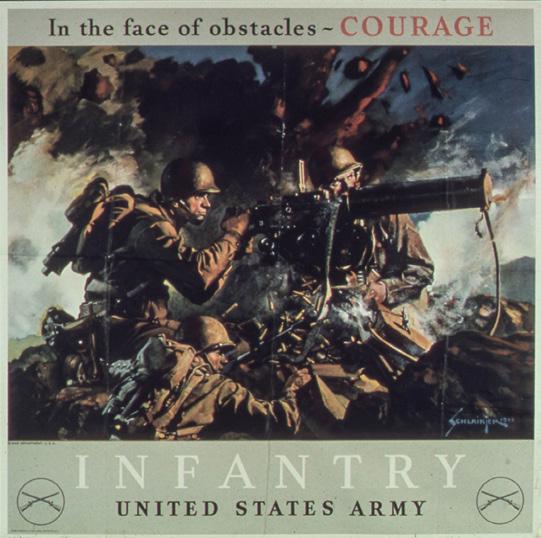
JOAN OF ARC SAVED FRANCE
Haskell Coffin, USA, 1918 Publisher: U. S. Treasury Department
Joan of Arc is a national heroine of France who rose to fame during the Hundred Years War between France and England from 1337-1453. Joan felt that she was guided by God to save France from the English invasion. She donned men’s clothes and led the French army to series of victories, most famously lifting the English siege of Orléans in 1429. She was eventually captured and executed by the English, but her popularity in France grew in the centuries after her death. In this American poster from World War I, Joan is dress in armor, usually reserved for men in the Medieval period, holding a sword, and looking upwards towards Heaven. The use of Joan of Arc and her efforts during the Hundred Years War in this poster implies that the women of American can save the United States through purchasing war bonds.

JOURNEE DE L’ARMEE D’AFRIQUE
ET DES TROUPES COLONIALES
Lucien-Hector Jonas, France, 1917
Publisher: Devambez
This poster is celebrating the French colonial troops. France had an extensive colonial empire during the 17th and 18th centuries, but in the decades prior to World War I, most of France’s colonial holdings were concentrated in Africa and Indochina, modern day Loas, Cambodia, and portions of Vietnam. Many imperial powers involved in the war drew manpower from their colonies and the French raised troops from the colonies in Africa and Indochina. On the right are two soldiers from one of France’s African colonies, possibly Senegal. On the left are two troops from Indochina, and French soldier in the center.
Translation: A Day for the African Army and the Colonial Troops

LET’S GIVE HIM ENOUGH AND ON TIME
Norman Rockwell, USA, 1942 Publisher: U. S. Army Ordnance Department
Painted by Norman Rockwell, this poster was displayed in ordnance plants throughout the United States to encourage workers. It depicts a U.S. soldier in a torn uniform firing a Browning 1917 machine gun surrounded by empty shell casing. The M1917 was water cooled, meaning that the jacket around the barrel was filled with water. The tube leading from the barrel to the tank in front of the gun was also filled with water. The cloth belt coming from the machinegun is a cartridge belt. Rounds would be fed into the belt and then the belt would be inserted in the machine gun so it could fire.
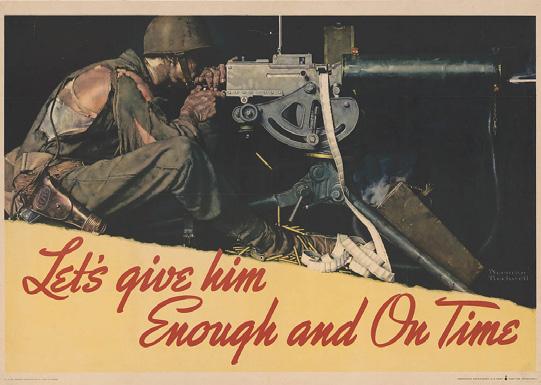
L’OR COMBAT POUR LA VICTOIRE
Abel Faivre, France, 1915 Publisher: Devambez
This poster draws upon traditional French symbolism to encourage monetary donations for the war effort. A German soldier is seen cowering from a rooster on a French coin. This rooster, known as the Gallic Rooster, originates to the Middle Ages where it used as a religious symbol. As France began to emerge as a nation during the Renaissance, the rooster became associated with France and was used by the Bourbon kings as a minor symbol of France. During the French Revolution, the rooster was featured on coins and the official seal of the Premier Consul, but was replaced by the eagle under Napoleon’s rule. In the Second Republic (1848-1852) and Third Republic (1870-1940), the rooster returned as a national symbol. During the First World War, the Gallic Rooster was seen as an icon of French patriotism. The words “Liberte, Egalite, Fraternite” on the coin harken back to the French Revolution and were the official motto of the Third Republic.
Translation: Deposit your gold for France. Gold fights for victory.

THE M–1 DOES MY TALKING!
Jes Wilhelm Schlaikjer, USA, exact date unknown Publisher: U. S. War Department
Like many other posters, this one focuses on urging Americans to be careful in their conversations and letters. A solider is depicted with his M–1 Garand rifle in his right hand and an en-bloc clip in the other. This poster is had another variation, with the bottom caption being “… with your cartidges.” Both variations were designed by Jes Wilhelm Schlaikjer.
YOU CAREFUL WHAT YOU SAY OR WRITE?
ARE

ME TRAVEL? NOT THIS SUMMER
VACATION AT HOME
Albert Dorne, USA, 1945 Publisher: Office of Defense Transportation
This post was produced in 1945 and despite the end of the Second World War being in sight, the U.S. Government was still encouraging rationing of gas and rubber tires. In this poster, a man is recreating what it would be like to be on vacation, probably at a beach, in his home. He has a fan blowing on him to mimic the wind and a glass and pitcher of lemonade on the side table. This, combined with his laid paid posture is meant to imply that American’s can enjoy the experience of being on vacation while staying at home and not using gas or putting wear on the tires of their vehicle.
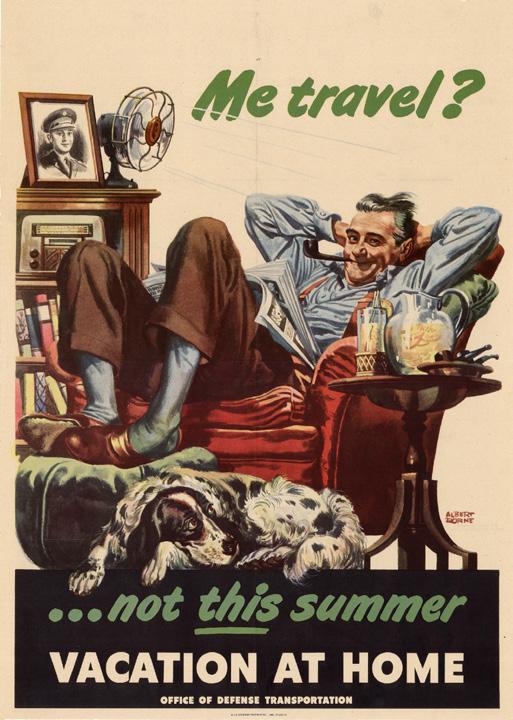
OF THE TROOPS AND FOR THE TROOPS
Jes Wilhelm Schlaikjer, USA, 1942 Publisher: U. S. War Department, Bureau of Public Relations
This poster in the series painted by Jes Wilhelm Schlaikjer depicts the U.S. Army’s Corps of Military Police. The Military Police, or MPs, have been an integral part of the United States Army since the American Revolution. The forerunners of the MPs, known as provosts, policed camps to arrest and detain thieves, rioters, and fugitives as well as guarded prisoners of war. By the Second World War, the size and role of the Military Police had dramatically expanded. By mid-1942, there were seventeen battalions of MPs in the Army. One battalion could have anywhere between 400 and 1,200 men and was commanded by a lieutenant colonel. They served a variety of functions including providing garrison forces, escort guards, guarding interior zones behind the front lines, guarding and transporting prisoners of war, and investigating criminal activity. By the end of the war, the corps of Military Police would be 200,000 men strong. The soldier in the poster can be identified as an MP by the black armband he wears on his left arm.
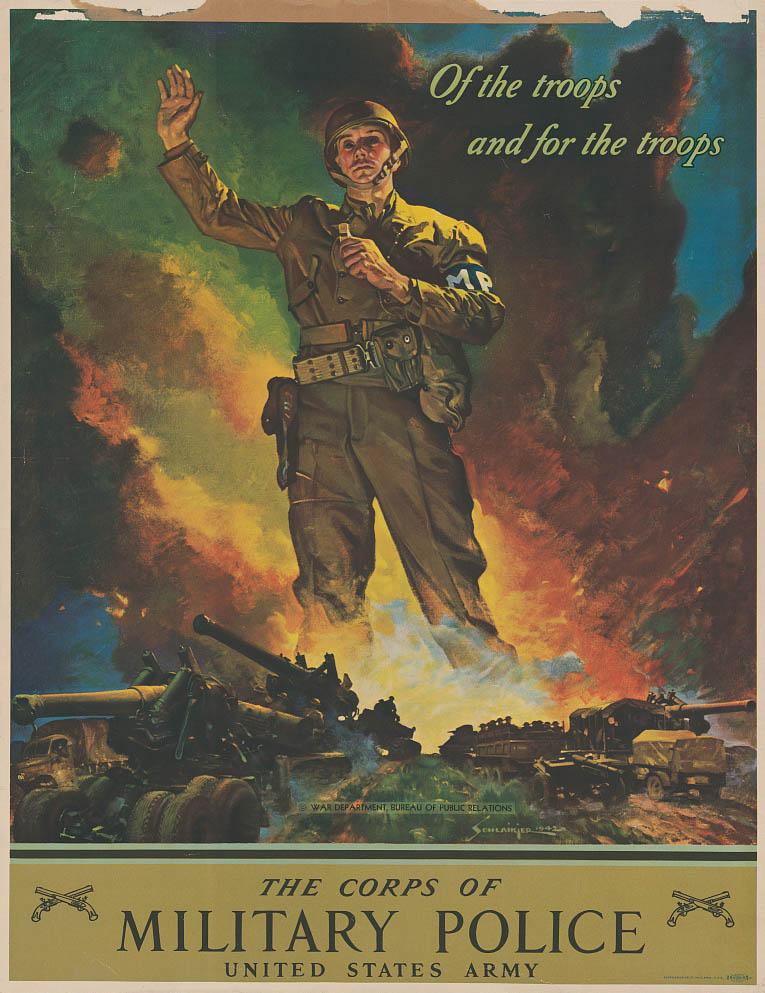
ON SOUSCRIT A LA BANQUE D’ALSACE ET DE LORRAINE
Jean-Jacques Waltz, France, 1918
Publisher: Lapina
This poster was designed by the famous French artist Jean-Jacques Waltz, also known as Hansi. He was born in Colmar, a town in Alsace, in 1873 which had been under German control for two years as a result of the Franco-Prussian War (1870-1871). Hansi felt more connection to France than Germany and began to draw anti-German caricatures and cartoons prior to World War I. He joined the French army in 1914 and in 1917 produced a poster showing French soldiers victoriously entering the city of Strasbourg, a major city in Alsace. The poster promoted France’s Third War Loan and urged French citizens to keep supporting the army so that Strasbourg would be reclaimed. His drawing was repurposed for this poster which promoted the Fourth War Loan in 1918. Both posters depict victorious French soldiers entering the Alsatian city of Strasbourg with French flags draped from nearly every window as well as the top of the cathedral in the background. Children dressed in traditional Alsatian clothes surround the soldiers as townsfolk
cheer. On the bottom left, two German figures, denoted by the grey-green color of their coats (this being the color of the German uniforms) and the tall boots on one of the figures, flee the city with several bags. The text at the top right says “The armies and their leaders/the government of the republic (of France)/Citizen George Clemenceau/ President of France/and Minister of War/ Marshall Foch/ Commander-in-Chief of the Allied Armies/ They have done well for France.” George Clemenceau served as the French Prime Minister and the Minister for War for the last year of the war. French Field Marshall Ferdinand Foch gained fame for his victory at the First Battle of the Marne in 1914 and was appointed Commander-in-Chief of the Allied Armies on the Western Front in 1918. The blue text on the bottom list various cities and towns in Alsace and Lorraine.
Translation:
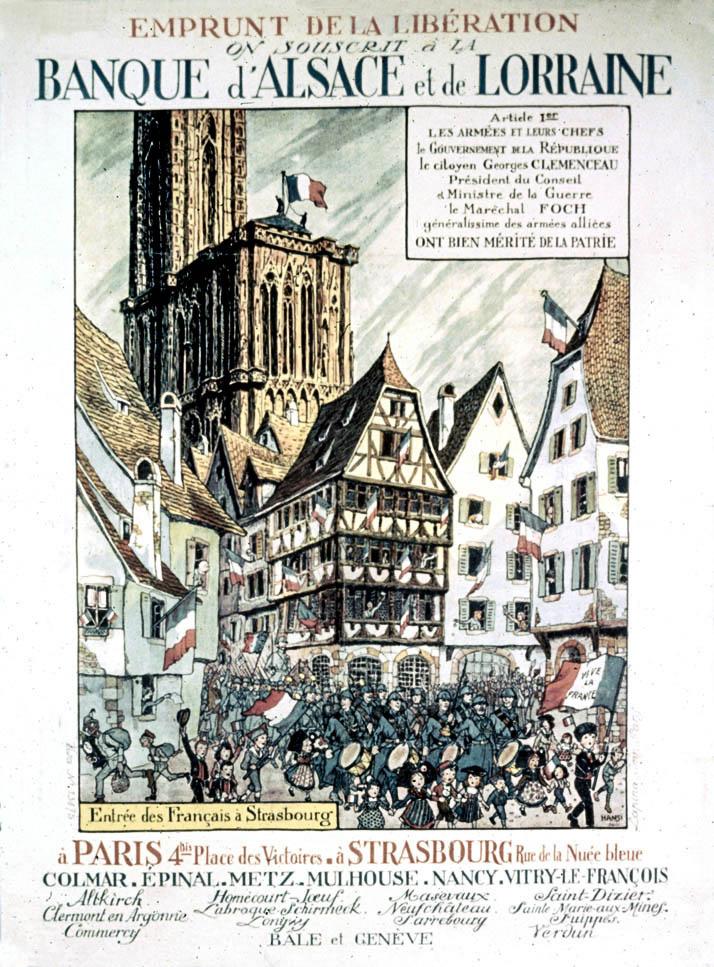
OUR CARELESSNESS
THEIR SECRET WEAPON
Unknown artist, USA, 1943
Publisher: U. S. Forest Service
While many posters were encouraging the purchase of war bonds, rationing, or increasing production in factories, others were encouraging Americans to be careful in their daily lives. The caption of this poster implies that forest fires, would be beneficial to the Axis powers, since wood was used in numerous military applications including rifle stocks and shipping crates. To reinforce the looming threat of the Axis powers, caricatures of Adolf Hitler and Hideki Tojo are depicted next to a burning forest. During the war, anti-Japanese propaganda posters typically depicted Japanese people with large, oversized teeth in an attempt to dehumanize Japanese people. Often times, the Japanese caricature was based off of Hideki Tojo, the prime minister of Japan, who sported a mustache and wore round glasses.
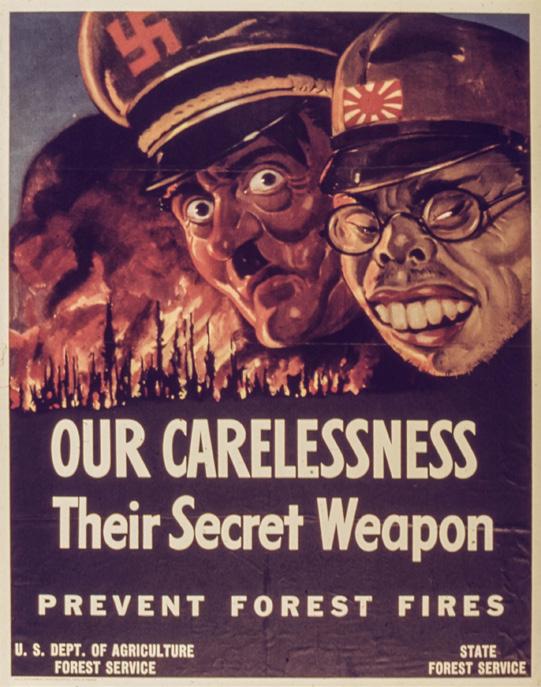
PARIS!
Unknown artist, France, 1944
Publisher:
Le Service d’Information Allie
On August 25, 1944, the French capital of Paris was liberated after four years of Nazi occupation. In the weeks after the Allied landings at Normandy, the liberation of Paris was overlooked for fear of the Allied advanced being slowed by urban fighting similar to that of Stalingrad in the winter of 1942-43. Additionally, Paris was not seen as a significant military target, despite Charles de Gaulle’s protests. When a strike of Parisian workers occurred on August 18 and fighting broke out between French Partisans and Nazi soldiers in the streets, General Dwight D. Eisenhower diverted troops to take the city. The 2nd Armored Division of the Free French Army, commanded by General Philippe Leclerc, and the U.S. 4th Infantry Division entered the city on the night of August 24 and by the following morning, the city was free.
Translation: Paris! 25 August 1944
25
AOUT 1944

POLISH WAR RELIEF EFFORT OF THE USA, INC.
Wladyslaw Tedor “W.T.” Benda, USA, exact date unknown Unknown publisher
Throughout the Second World War, numerous societies and organizations were established to provide aid to countries in Europe and Asia. Polish War Relief was established in 1940 and by September 1945 had sent over $11 million in cash and gifts to Poles around the world. The group sent medicine, food, schools, supplies, and other materials as part of their outreach. Poland was invaded by Nazi Germany and the Soviet Union in September 1939 and its citizens experienced tremendous hardships and suffering. This poster depicts emaciated, half clothed Polish children with dismayed expressions on their faces. In an effort to receive donations, the poster plays upon the sympathies of American citizens.

POUR LE SUPREME EFFORT
M. Falter and Atetien Pichon, France, 1918 Publisher: L’imprimerie Chaix
Promoting the National War Loan in France, this poster draws upon historic symbolism to encourage participation. A French soldier is seen choking a large black eagle on a battlefield. The black eagle had a symbol of Prussia since the Middle Ages. The helmet seen at the bottom right of the poster is a pickelhaube, a helmet traditionally worn by Prussian soldiers. There was long held animosity between France and Prussia, especially since Prussia was the leading power in the unification of the German States. After defeating the French and capturing Emperor Napoleon III during the Franco-Prussian War (1870-1871), a confederation of German states, led by Prussia, proclaimed the creation of the German Empire at the Palace of Versailles, the traditional seat of French monarchs since Louis XIV. Stinging from this humiliation, the French saw an opportunity for revenge during the later stages of World War I. Drawing upon Prussian symbolism and the desire for revenge, this poster encourages donations to the war effort to secure France’s revenge.
Translation: For the supreme effort
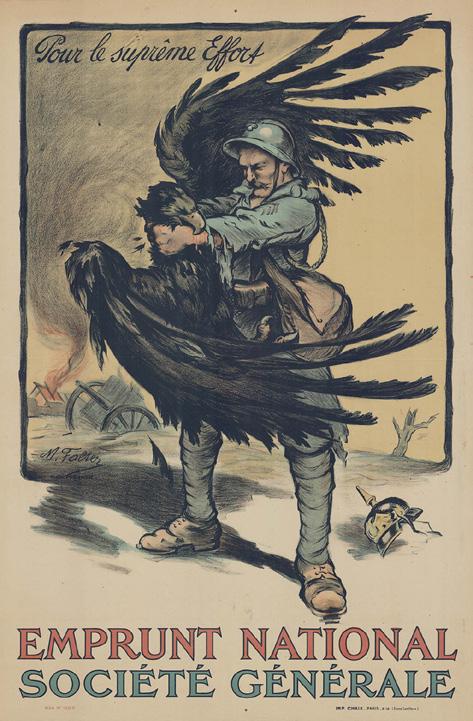
PVT. JOE LOUIS SAYS…
Unknown artist, USA, 1942
Publisher: Office of Facts and Figures, War Department
Joe Louis, nicknamed the Brown Bomber, was a famous American boxer who held the world heavyweight title from June 1937 to March 1949. Louis enlisted in the U.S. Army in 1942 after the surprise attack on Pearl Harbor and served with Jackie Robinson, the first African American to play major league baseball. Louis did not see combat, but his fame and status made him a perfect candidate for advertising war bonds. Utilizing a quote he said during a fundraiser as the caption, this poster shows Louis in full combat gear thrusting his bayonet affixed rifle. The poster and slogan gained rapid popularity and helped the idea that the United States was on the right side of the war. Further capitalizing on his popularity, Louis was assigned to an Army organized all-black boxing group, which put on exhibition matches in Europe and the United States.
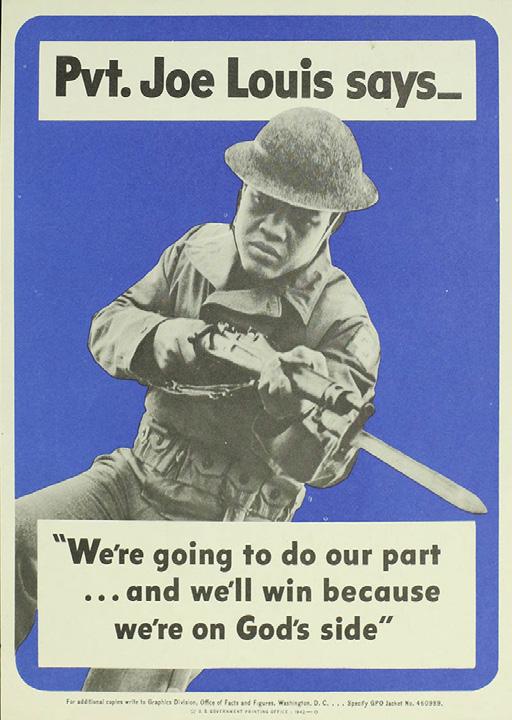
SAVE YOUR CANS
HELP PASS THE AMMUNITION
McClelland Barclay, USA, 1943 Publisher: War Production Board, Salvage Division
In addition to rationing, Americans were also encouraged to recycle products for military use. Excess cooking grease could be used to make explosives and scrap metal could be turned into everything from shell casing to aircraft frames. This poster depicts an American woman, most likely a housewife, feeding cans into the ammunition belt of a machinegun. They gradually transform from cans into cartridges, implying that by donating used cans, Americans could directly help the soldiers on the front lines. The bottom of the poster also contains instructions for how to get the cans ready for recycling.
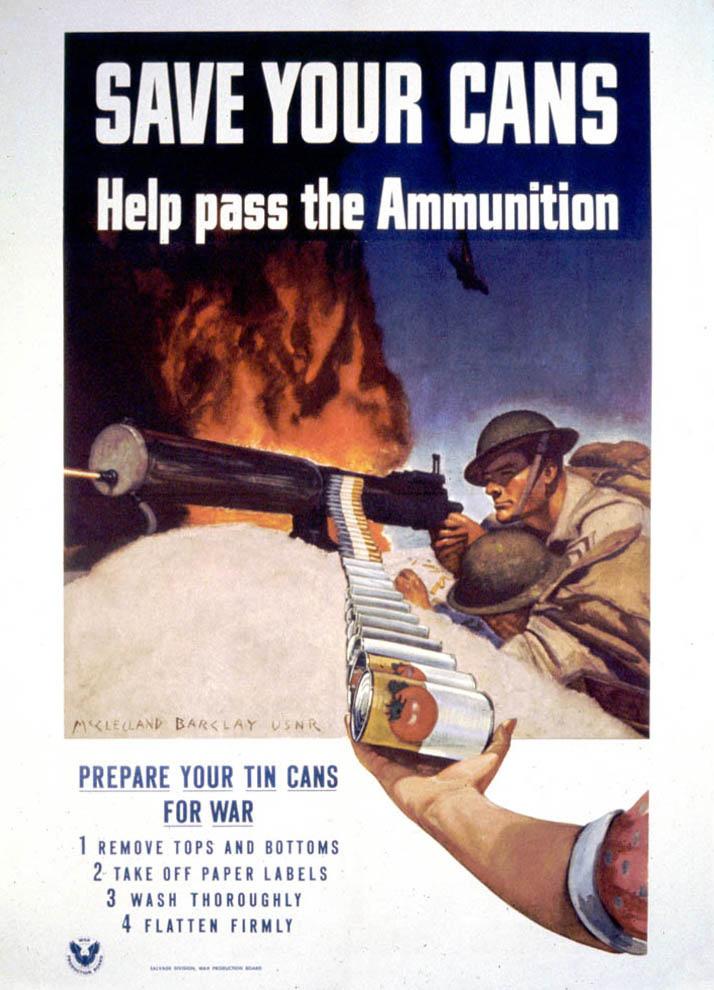
SERVICE ABOVE SELF
Jes Wilhelm Schlaikjer, USA, 1942
Publisher: U. S. War Department, Bureau of Public Relations
This Jes Wilhelm Schlaikjer poster depicts a medic tending to a wounded soldier. Identified by the red cross on their armbands and helmets, combat medics played a vital role during World War II. When a soldier was wounded or injured, combat medics would provide aid to stabilize the soldier before transporting him to a field hospital for further treatment. One of the most famous combat medics of the war was Corporal Desmond Doss, who served in the Pacific. Doss, a native of Lynchburg, VA, was a Seventh Day Adventist who refused to use a weapon but still wanted to serve his country. On Okinawa in 1945, his unit was tasked with taking Hacksaw Ridge, a high plateau that the Japanese were heavily defending. After the failed attack left many wounded Americans stranded on the cliff, Doss single handily rescued seventy-five American soldiers over a twelve-hour period. For his bravery, Doss was awarded the Medal of Honor.

SILENCE MEANS SECURITY
Jes Wilhelm Schlaikjer, USA, 1945 Publisher: Office of War Information
This poster depicts an American soldier carefully making his way through terrain. Presumably, the soldier is on patrol scouting for the enemy and is doing his best to keep silent to avoid detection. This poster is designed to stress the importance of American citizens being careful about what they say or write. If enemy spies overhear important military intelligence, it could cost American soldiers their lives, just like unnecessary noise on a military patrol.
CAREFUL WHAT
SAY OR WRITE
BE
YOU
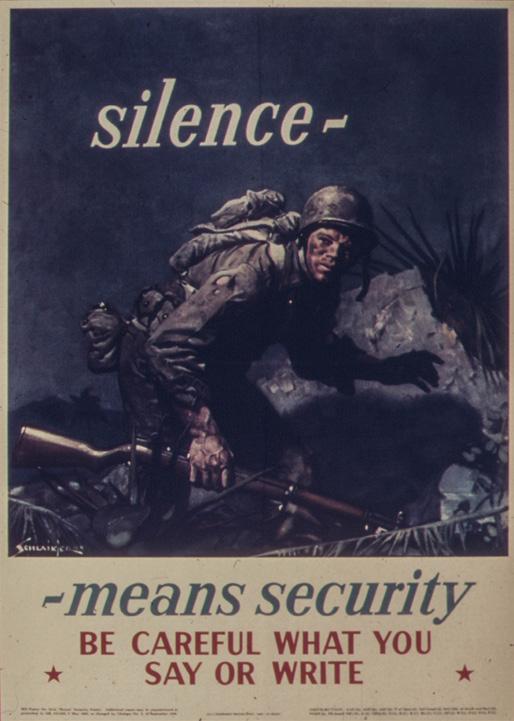
SO WIE WIR MITLEIDLOS HART GEWESEN SIND IM KAMPF UM DIE MACHT…
Unknown artist, Nazi Germany, exact date unknown Publisher: Wochenspruchen der Nationalsozialistische Deutsche Arbeiterparte
This poster was part of a larger propaganda program known as Wochensprechen der NSDAP, which translates to Weekly Quotation of the Nazi Party. Running from 1937 to 1944, this program used quotations from Adolf Hitler, German historical figures or Nazi Party members to produce posters to spread the ideas and goals of the Nazi Party. In this instance, a quote from Adolf Hitler is used. The quote is surrounded by imagery that seems to reinforce the militaristic and industrial aspects of the Nazi Party: a dagger, a hammer, and a gear.
Translation: Just as we are pitiless, hard fought for power, we will be just as pitiless and tough in the struggle for the preservation of our people.

SOMEONE TALKED!
Frederick Siebel, USA, 1942
Publisher: Office of War Information, no. 18
This is another poster warning Americans about being careful with what they discussed in conversations. The threat of Axis spies infiltrating the United States was paramount in the minds of government and military officials. If any information pertaining to military efforts were leaked to the enemy, intentionally or unintentionally, it could be disastrous for the troops. The accusatory tone of the caption and pose by the soldier highlight this reality for Americans viewing the poster.
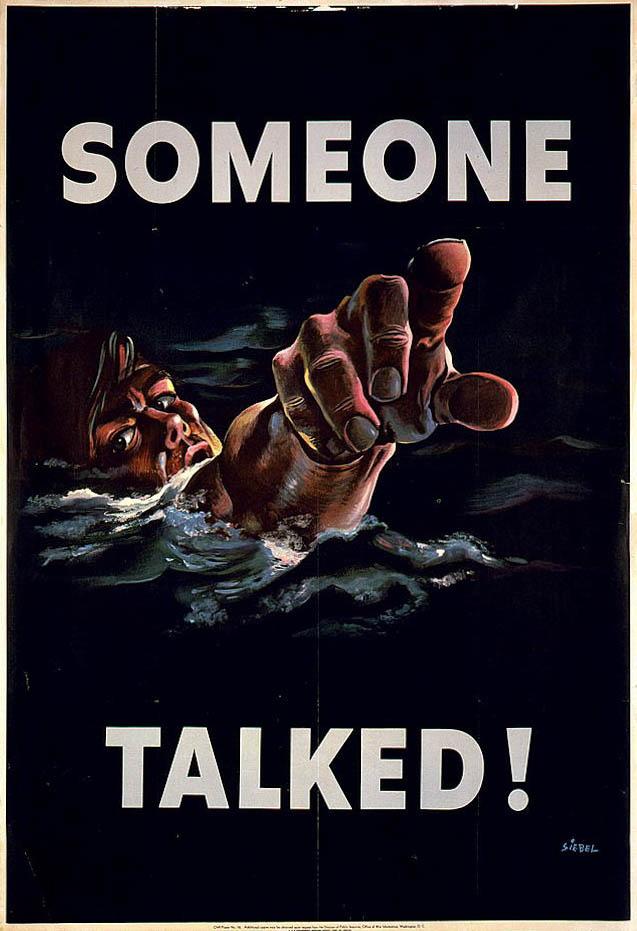
THE MORE WOMEN AT WORK THE SOONER WE WIN!
Alfred
Palmer,
USA, 1943 Publisher: Office of War Information, no. 52
As men enlisted or were drafted in the Second World War, there were numerous jobs left vacant. In order to both keep the economy moving and to help produce material for the war effort, women were encouraged to enter the workforce. This poster depicts a woman working, most likely on the screen of a turret for an aircraft, while the caption underneath lists the other types of jobs that were available to women. After the war ended, many women left the work force, but their essential role during the war helped give them more autonomy and power in the post-war era.

THEY’RE CLOSER THAN YOU THINK!
Unknown artist, USA, 1942
Publisher: US Army, Ordnance Department
Produced by the U.S. Army Ordnance Department in 1942, this poster illustrates the looming threat of the Axis powers. A factory worker, surrounded with warm yellow light, is seen working while a German and Japanese soldier stare at him in the background. The way the Axis soldiers are drawn and the dark background gives them a monstrous appearance. Anti-Japanese sentiment is clear in this poster, as the Japanese soldier is depicted as a caricature of Hideki Tojo, the Japanese prime minister, with large buck teeth and small eyes.
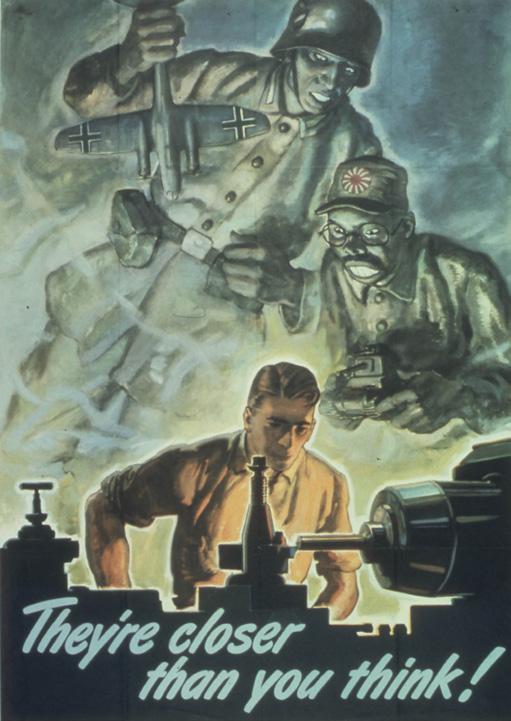
UN DERNIER EFFORT ET ON L’AURA
Possibly François Courboin, France, 1917 Publisher: Cornielle & Serre
Published in 1917, this French poster shows that the First World War may be over soon. Various soldiers from Allied nations, including France, the United Kingdom, and the United States are seen climbing a large rock with an eagle pearched atop. The Iron Cross, a German military decoration, is blood stained and the eagle, symbolizing Imperial Germany, looks haggered as its tail feathers are falling out. The reason for this sudden optimism in the war’s end was a result of the United State’s entrance into the war on April 6, 1917. After remaining neutral for almost three years, the entrance of the United States meant that the Allied powers would benefit from the United States’ industrial capacity and its massive population for more troops.
Translation: One last effort and we’ll beat them.
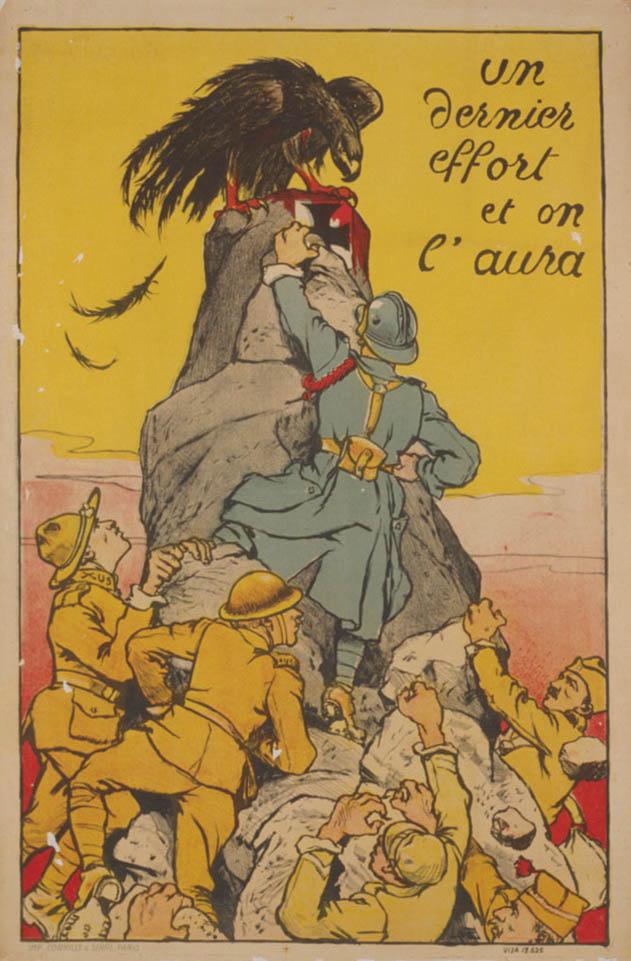
UNTEROFFIZIER IM HEER DEIN BERUF!
Unknown artist, Nazi Germany, exact date unknown
Publisher: Meissner & Busch
Like the Allied Powers, Germany used propaganda posters as a recruiting tool during World War II. This poster shows a sergeant in profile while encouraging viewers to enlist for military service.
Translation: Sergeant in the army: your job!

VIVE LA NATION!
Adolphe Leon Willette, France, 1917 Publisher: Devambez
Produced in 1917, this French poster is designed to invoke the French Revolution. The figure, presumably a woman, is dressed in a military uniform with the colors red, white, and blue, the colors of France. She wears a bicorn hat with a tricolor cockade, a common symbol used to distinguish those who supported the Revolution. She is playing a military style drum, which were used to issue commands on the battlefield and inspire troops before they entered battle. Given that this poster was produced in 1917, its possible that this poster is meant to inspire and encourage the French people as they were in the fourth year of the war.

THE SPIRIT OF WAR CAMP COMMUNITY SERVICE
Unknown artist, USA, 1918
Publisher: Heywood Strasser & Voight Lithography Company, NY
From November 11–18, 1918, seven civilian organizations raised funds for providing morale boosts for American soldiers as a part of the United War Work Campaign. War Camp Community Service was one of these seven organizations and specialized in providing entertainment and activities for soldiers who were not in military camps. The organization worked with local governments to provide concerts, athletic contests and clubs for enlisted men. Additionally, to combat homesickness, War Camp Community Service established a program where soldiers would have Sunday dinner at private residences. This poster depicts a group of three soldiers having dinner at a private home.

WE CLEAR THE WAY
Jes Wilhelm Schlaikjer, USA, 1942 Publisher: U. S. War Department
Like the Military Police, the Corps of Engineers can trace its origins to the American Revolution. In World War II, the Corps of Engineers oversaw building new military installations and bases both in the United States and abroad. In combat, engineers played a crucial role in helping the Allies win the war. They built temporary permanent bridges across important rivers, like the Rapido in Italy and the Rhine in Germany, allowing Allied troops to continue being combat effective. During the Normandy landings on June 6, 1944, combat engineers cleared heavy obstacles preventing vehicles and landing craft from moving up the beach. During the Battle of the Bulge, a lastditch effort by Germany to stop the Allied advance from December 1944 to January 1945, engineers destroyed key bridges which slowed down the German assault. Though a largely overlooked section of the U.S. Army, the Corps of Engineers were invaluable in the war effort, both domestically and on the frontlines.

WEAPONS FOR LIBERTY
Joseph Christian Leyendecker, USA, 1917 Publisher: American Lithographic Company, NY
This poster is advertising the Third Liberty Loan, which began in April 1918. Like other Liberty Loans and War Drives, bonds were sold to the American public to raise money for the war effort. This poster shows a Boy Scout, kneeling like a squire for a medieval knight kneeling in front of a female figure, possibly Lady Liberty. The Boy Scout is handing a sword with the Boy Scout motto to the female figure, who is dressed in an American flag. She also carries a gold shield with the seal of the United States on the front. The phrase at the bottom of the poster implies that these funds were going to be used to purchase weapons for American soldiers.
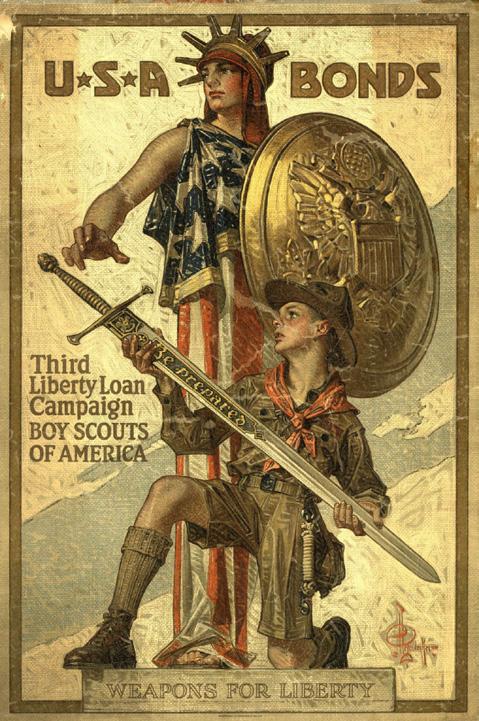
WHERE SKILL AND COURAGE COUNT
SIGNAL CORPS UNITED STATES ARMY
Jes Wilhelm Schlaikjer, USA, 1942 Publisher: US War Department, Bureau of Public Relations
The Signal Corps during the Second World War were responsible for communication and information collection. Their duties included operating radar installations, developing and operating portable radios, taking photographs, creating training films, utilizing homing pigeons, gathering intelligence, and monitoring communication lines for security breaches. These duties were performed by over 350,000 soldiers and officers throughout the war and members of the Women’s Army Corps worked alongside members of the Signal Corps in operating communication stations.
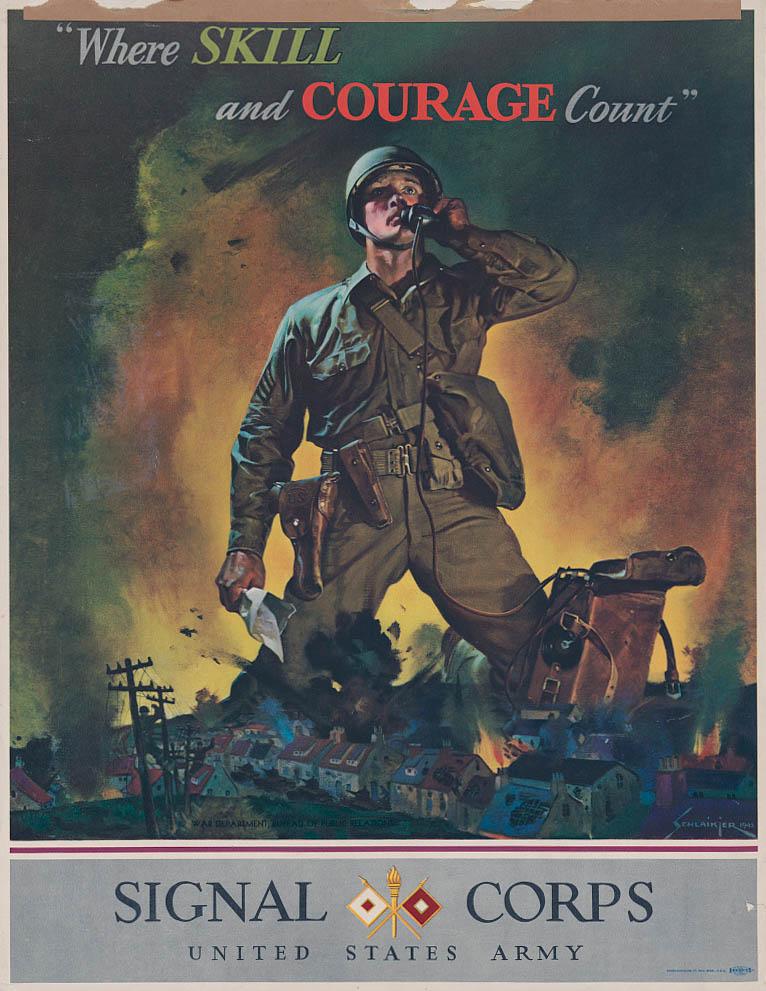
YOU CAN LICK RUNAWAY PRICES
James Montgomery Flagg, USA, 1943 Publisher: Office of War Information for the Office of Economic Stabilization
This poster by James Montgomery Flagg utilizes the image of Uncle Sam that he created during the First World War. Part of the Seven Keys to Victory poster series, this poster highlights seven ways Americans can help financially support the war effort including paying taxes, following rationing regulations, and buying war bonds. During the Great Depression, only a small percentage of Americans filed tax returns, but as the United States entered the war, more and more people began to file their taxes. By 1945, about 50 million people were filing their taxes. This increase in revenue allowed the United States to support its Lend-Lease program with Allied Powers and eventually support American troops.
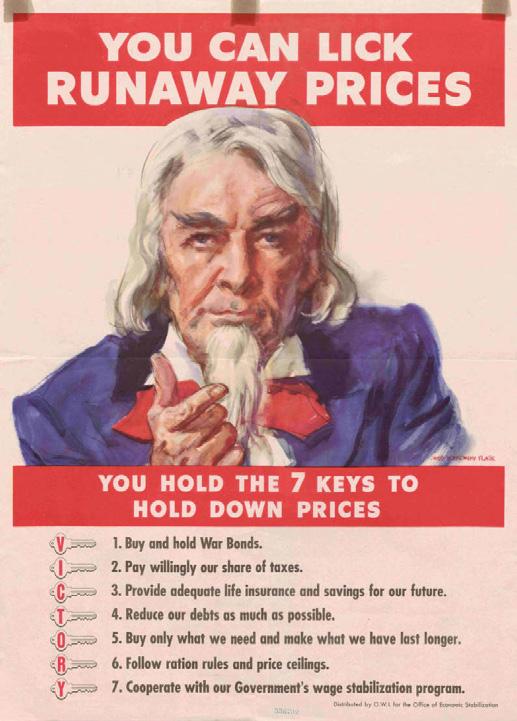
YOUR VICTORY GARDEN COUNTS MORE THAN EVER!
Hubert Morley, USA, 1945 Publisher: War Food Administration
During the Second World War, Americans received ration books which limited the amount and number of products that they could buy to ensure enough supplies were available for the troops. In order to supplement their diets, Americans were encouraged to grow Victory Gardens. About half of all American families during the war had a Victory Garden and grew various types of produce including tomatoes, peas, beans, and potatoes. This effort was a tremendous success and by the end of the war, American families had grown nearly 8 million tons of food.


P.O. Box 1600, Lexington, VA 24450
 IN THE GEORGE C. MARSHALL FOUNDATION
IN THE GEORGE C. MARSHALL FOUNDATION







































































